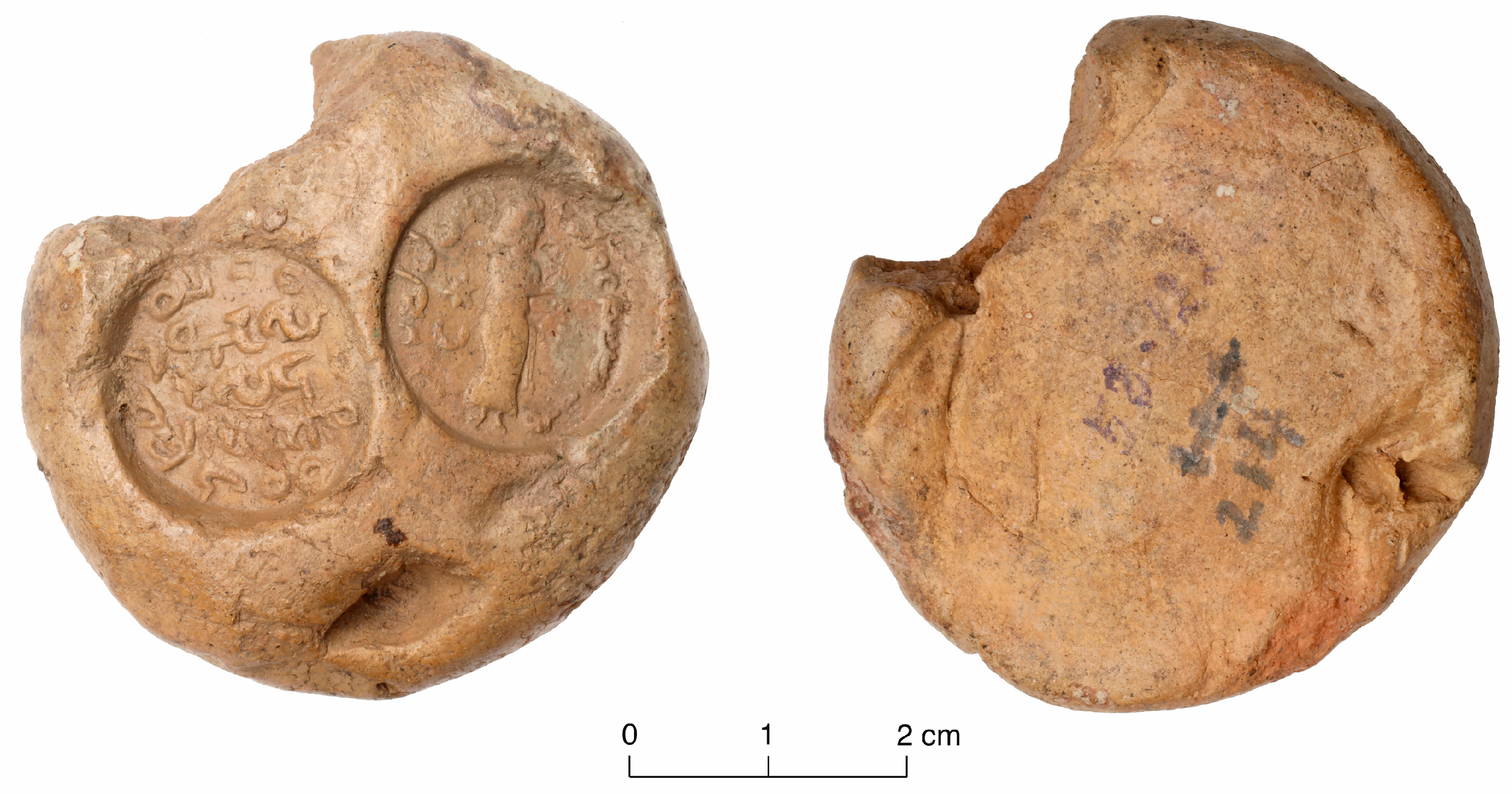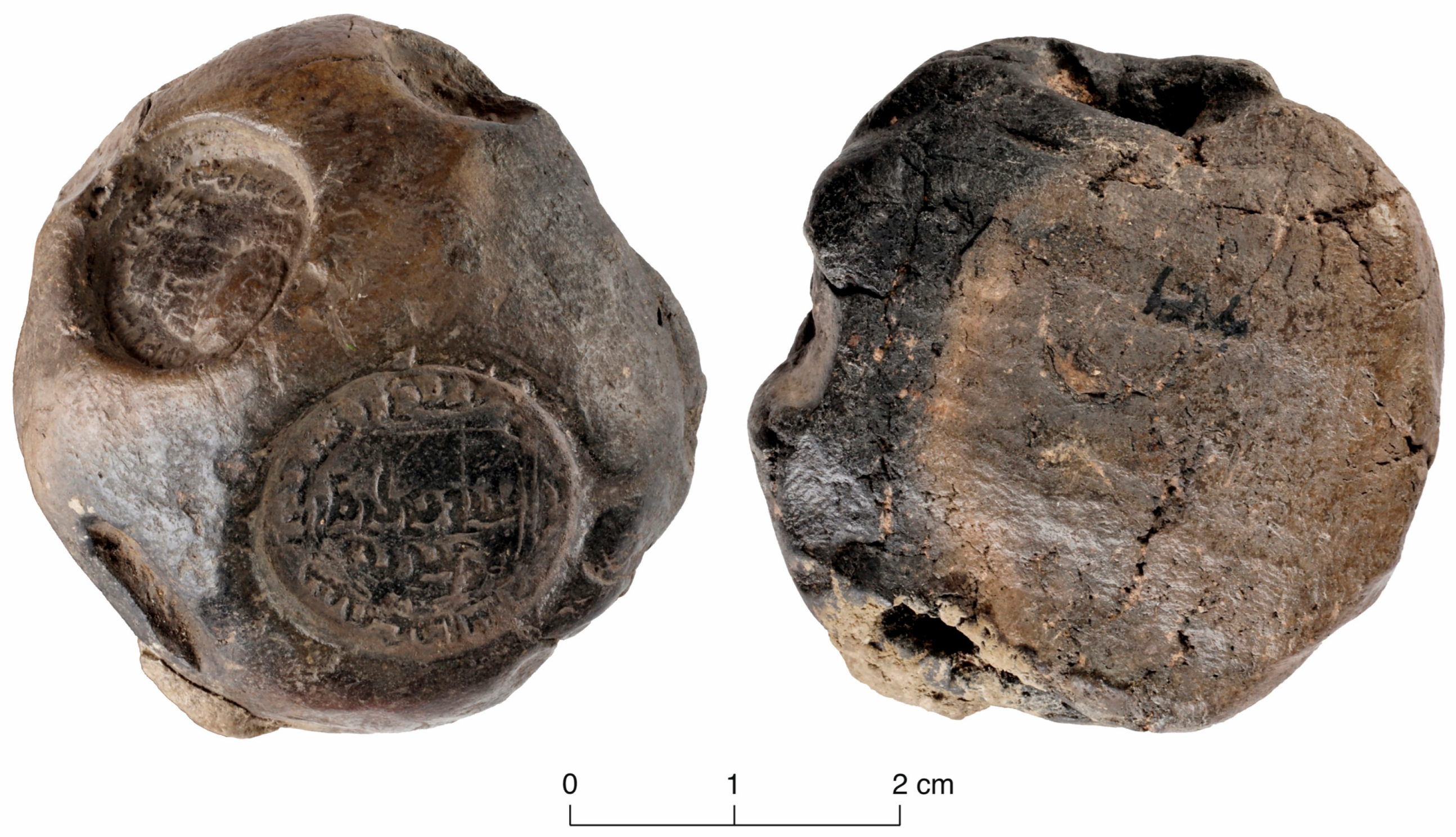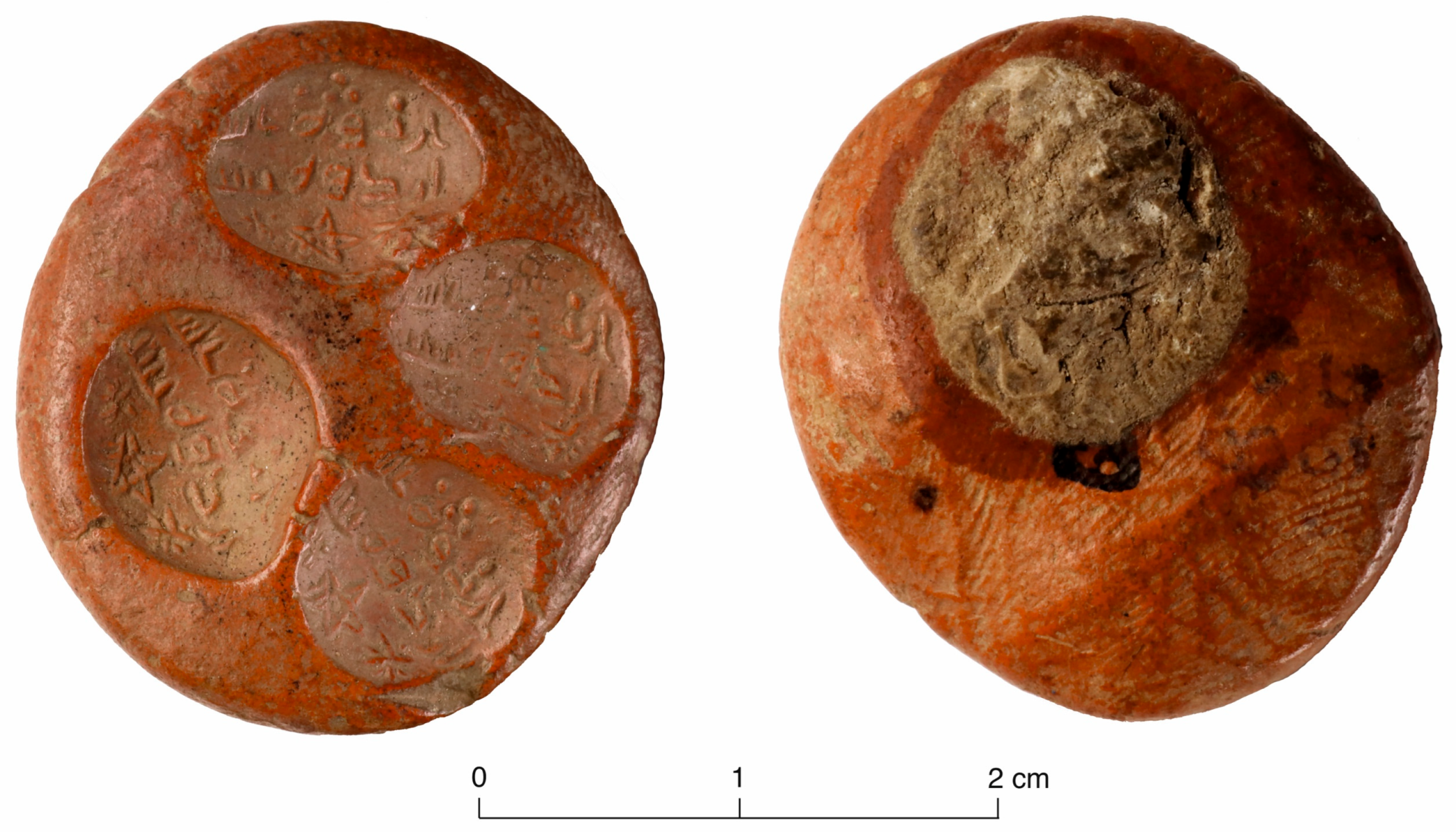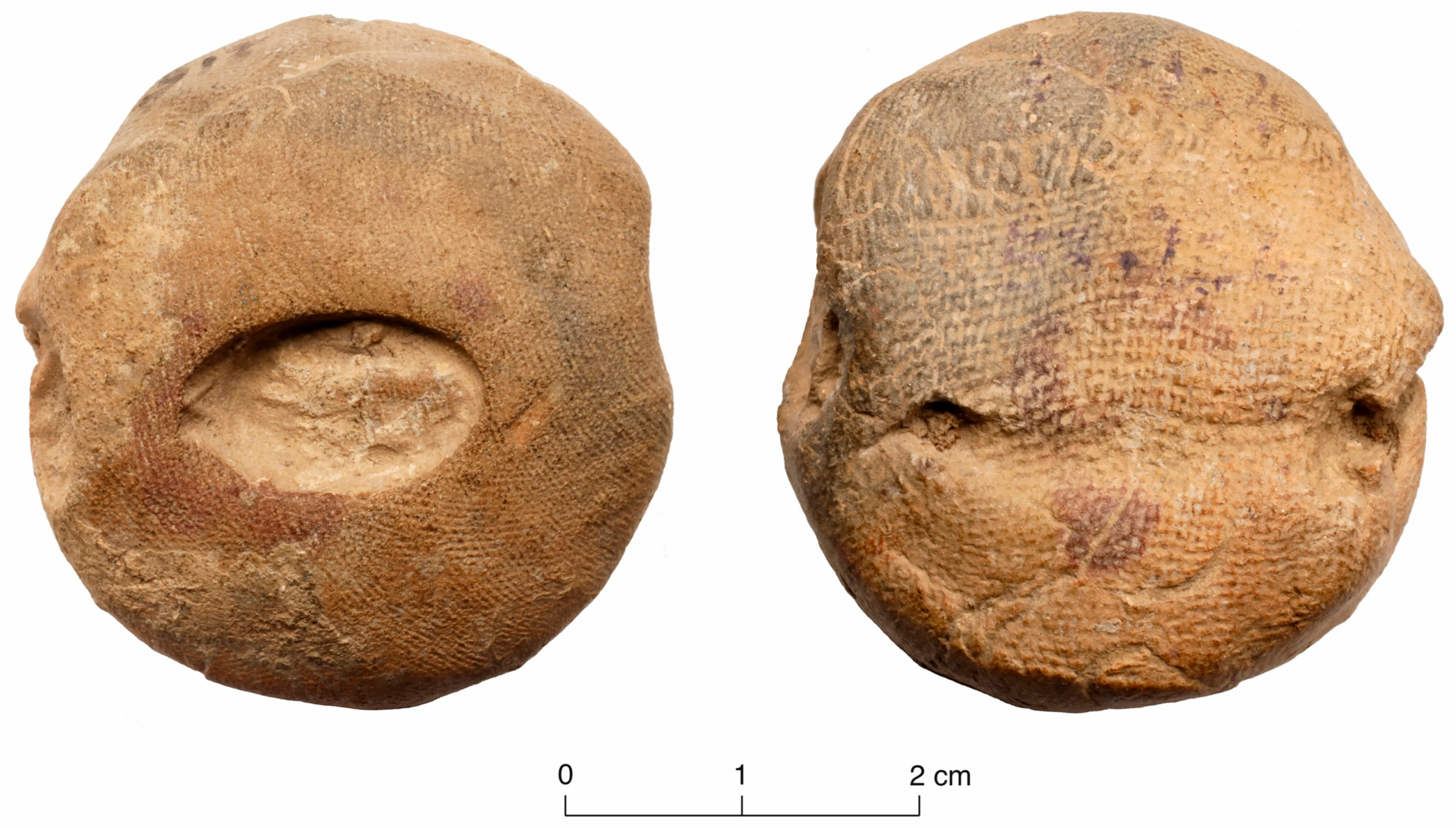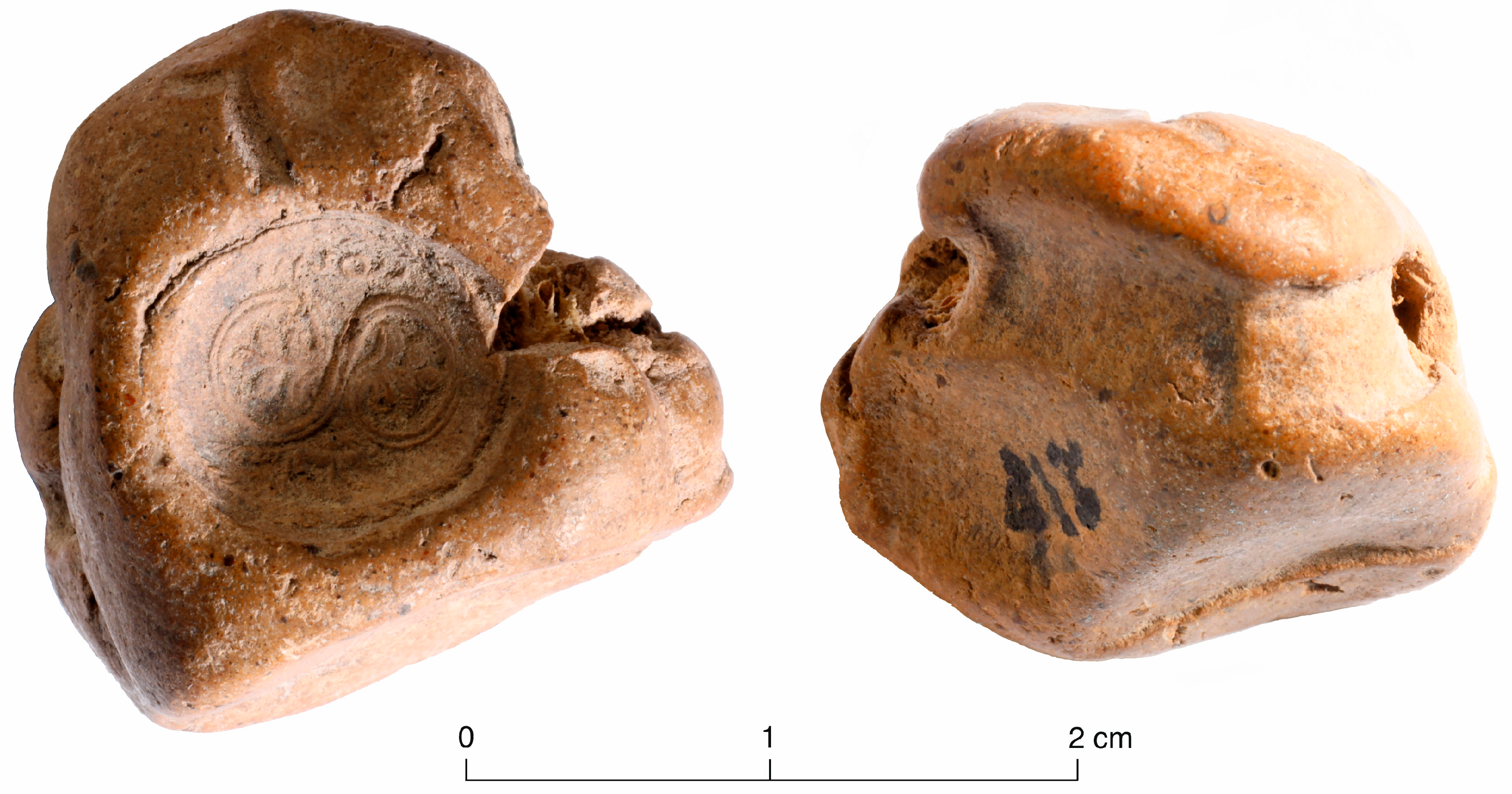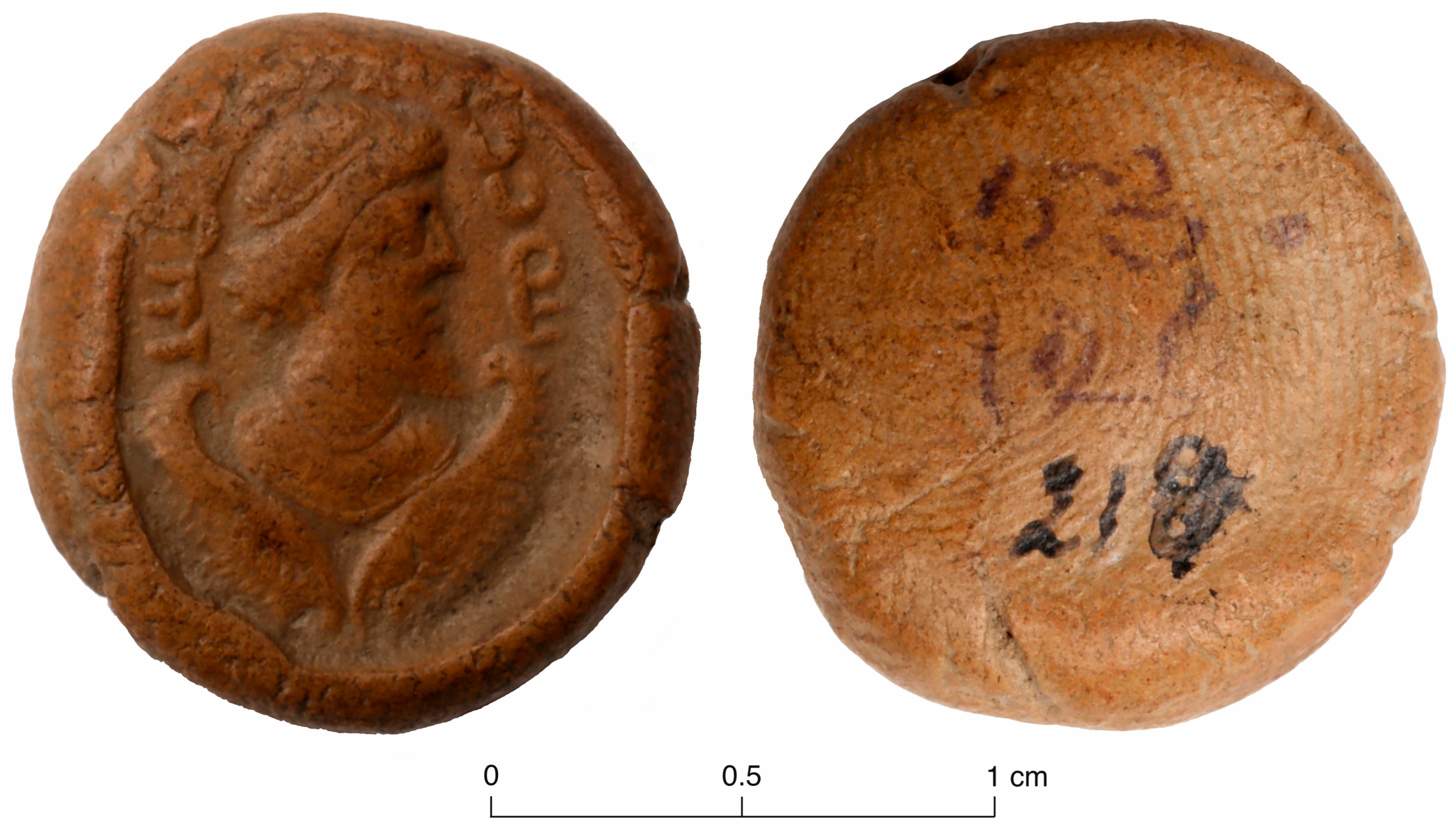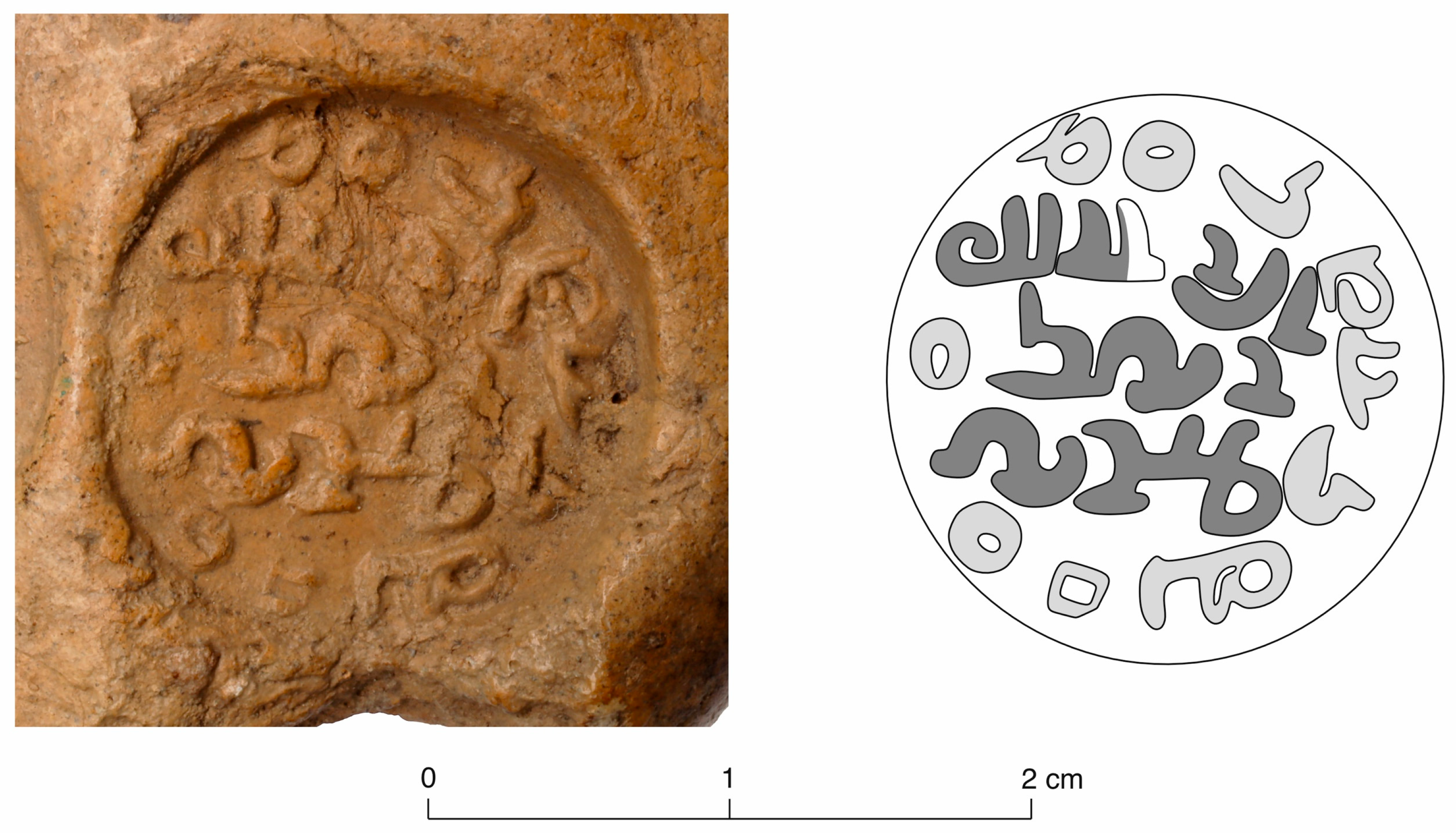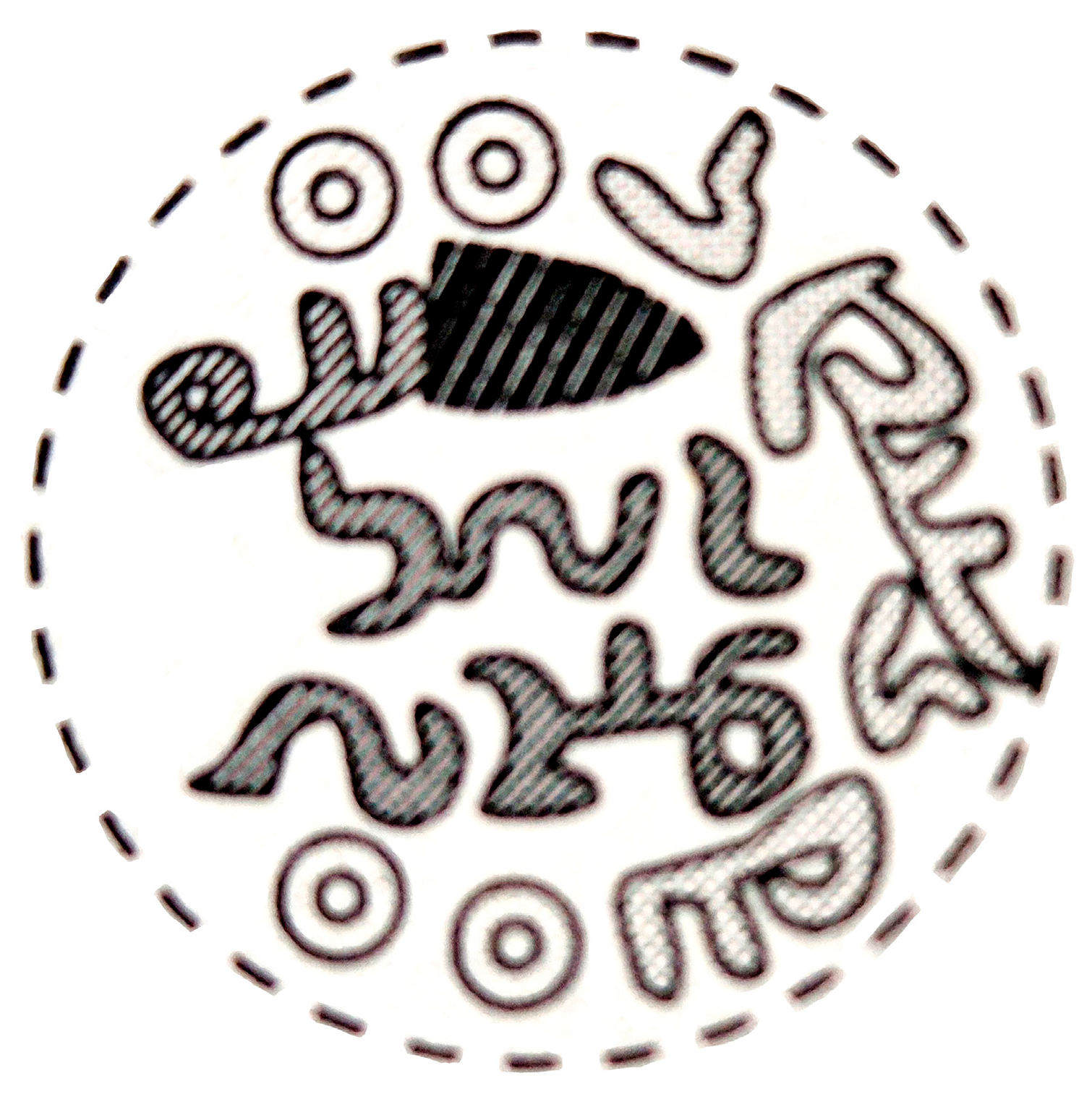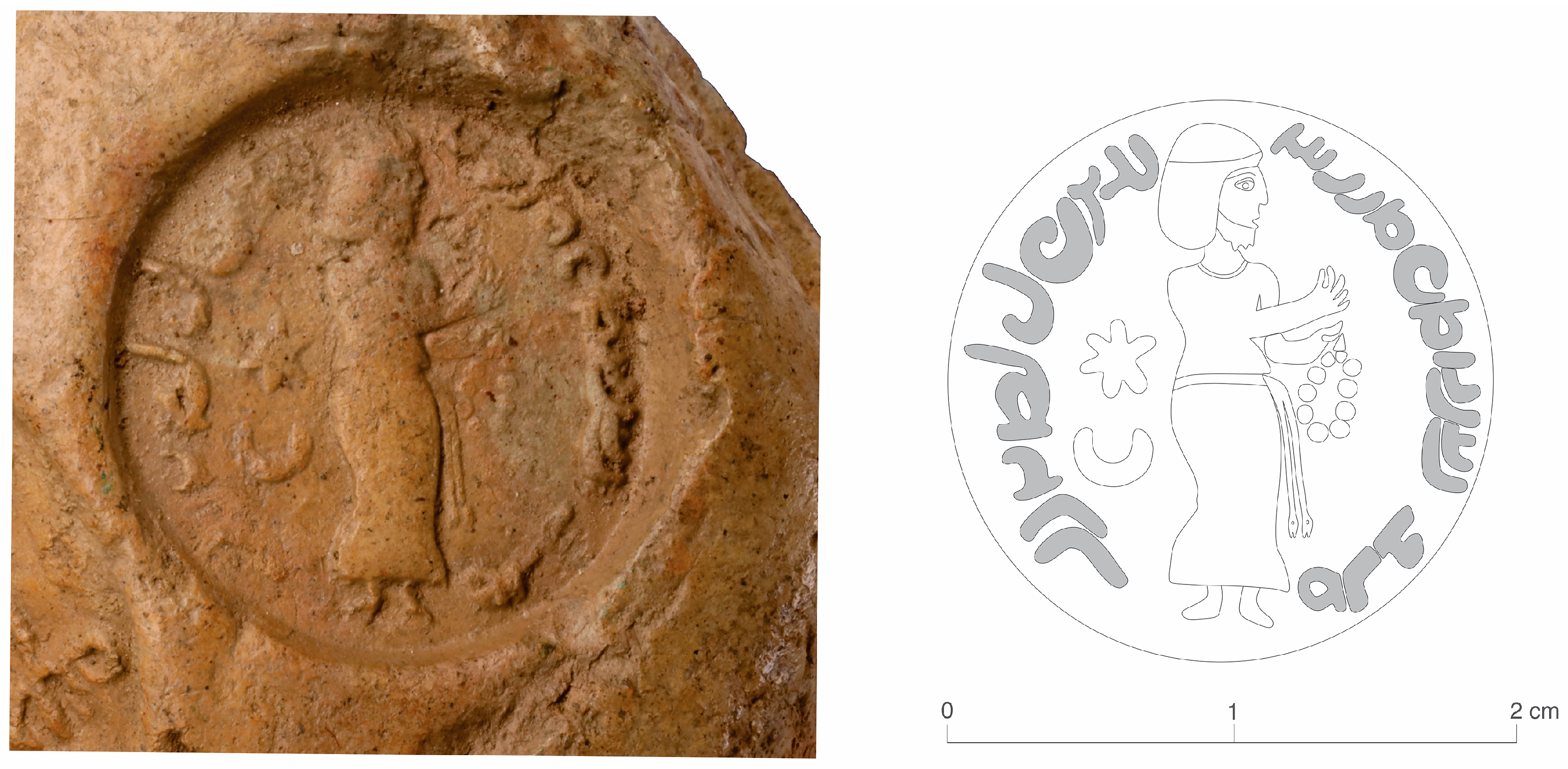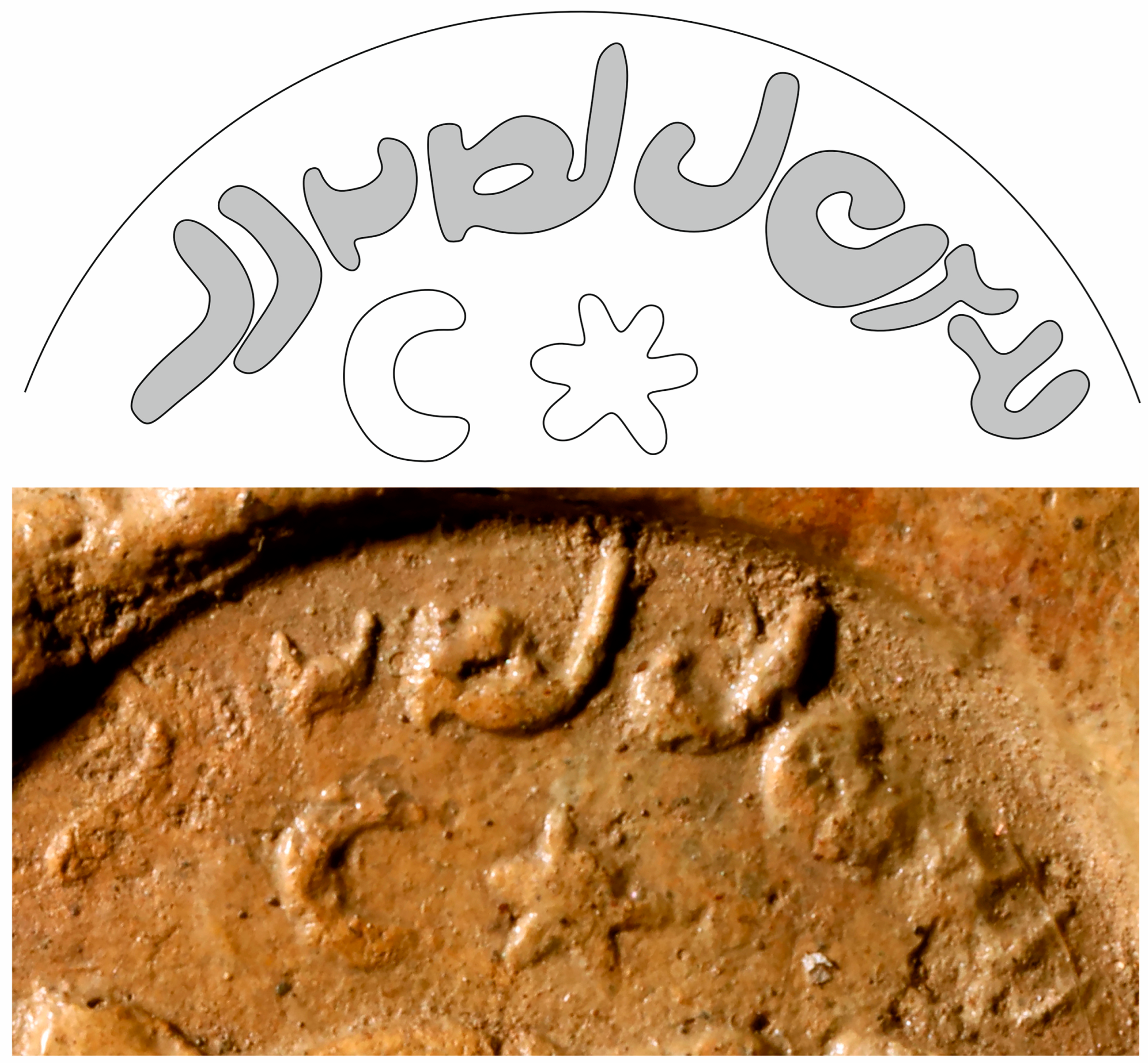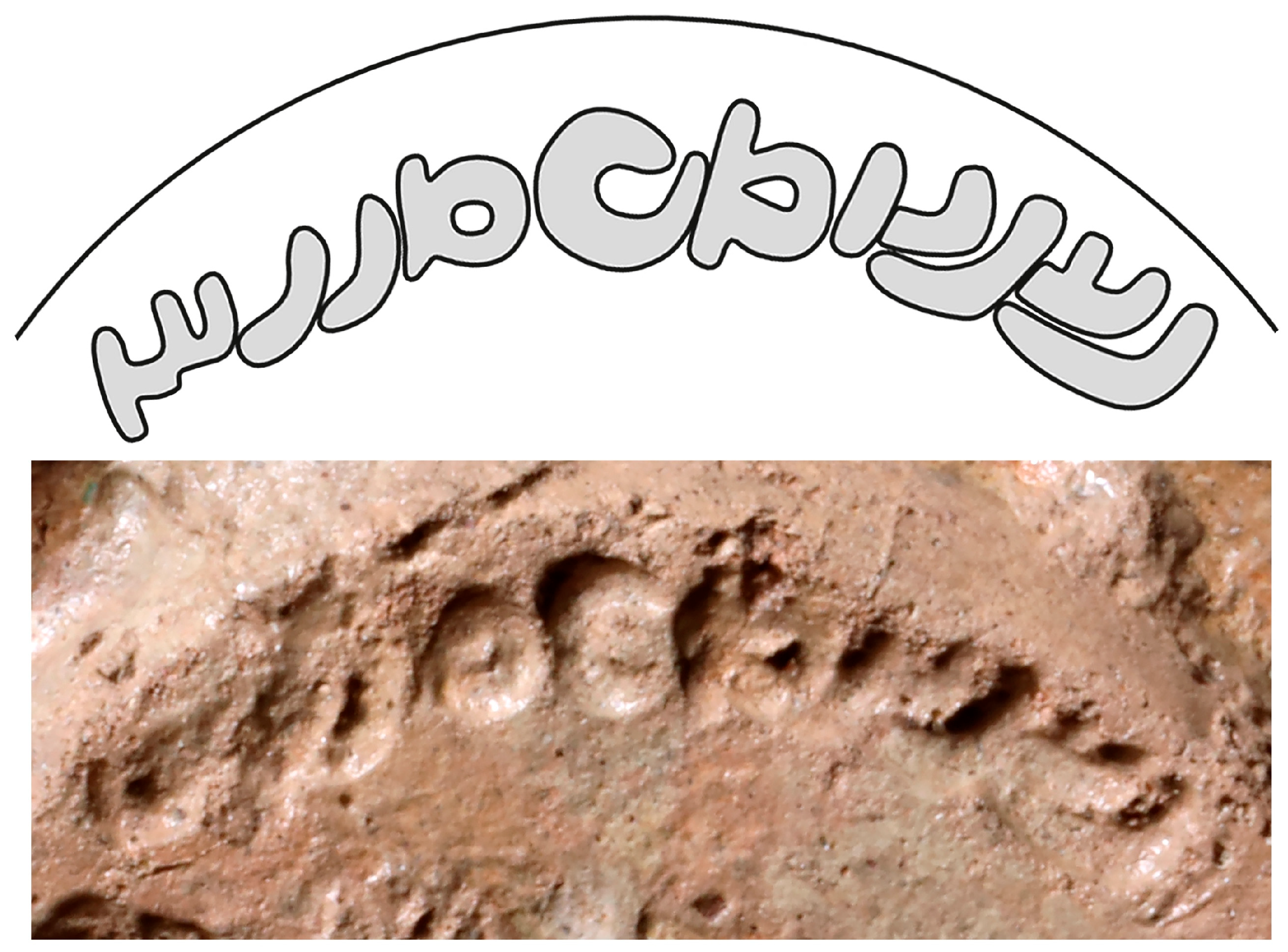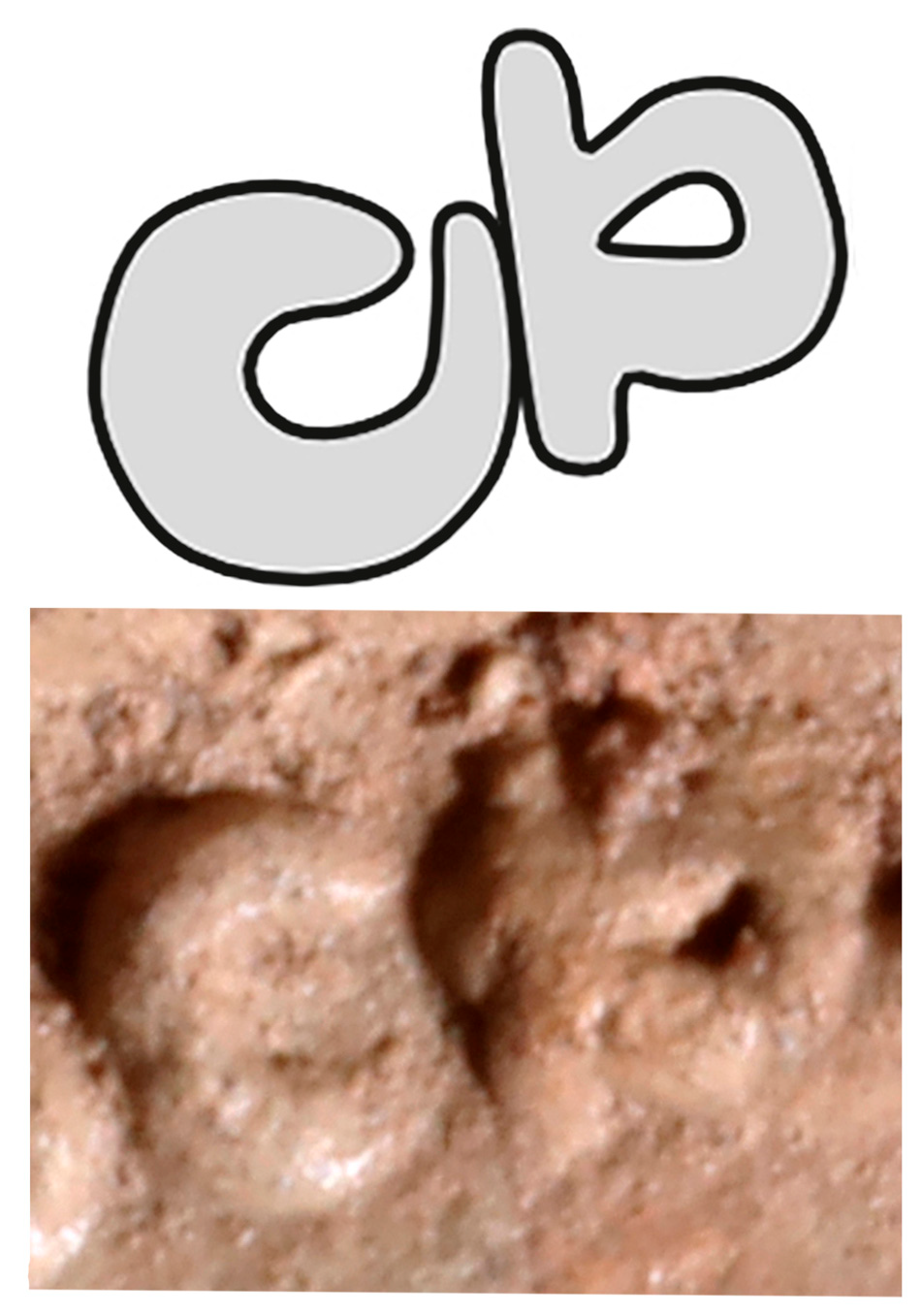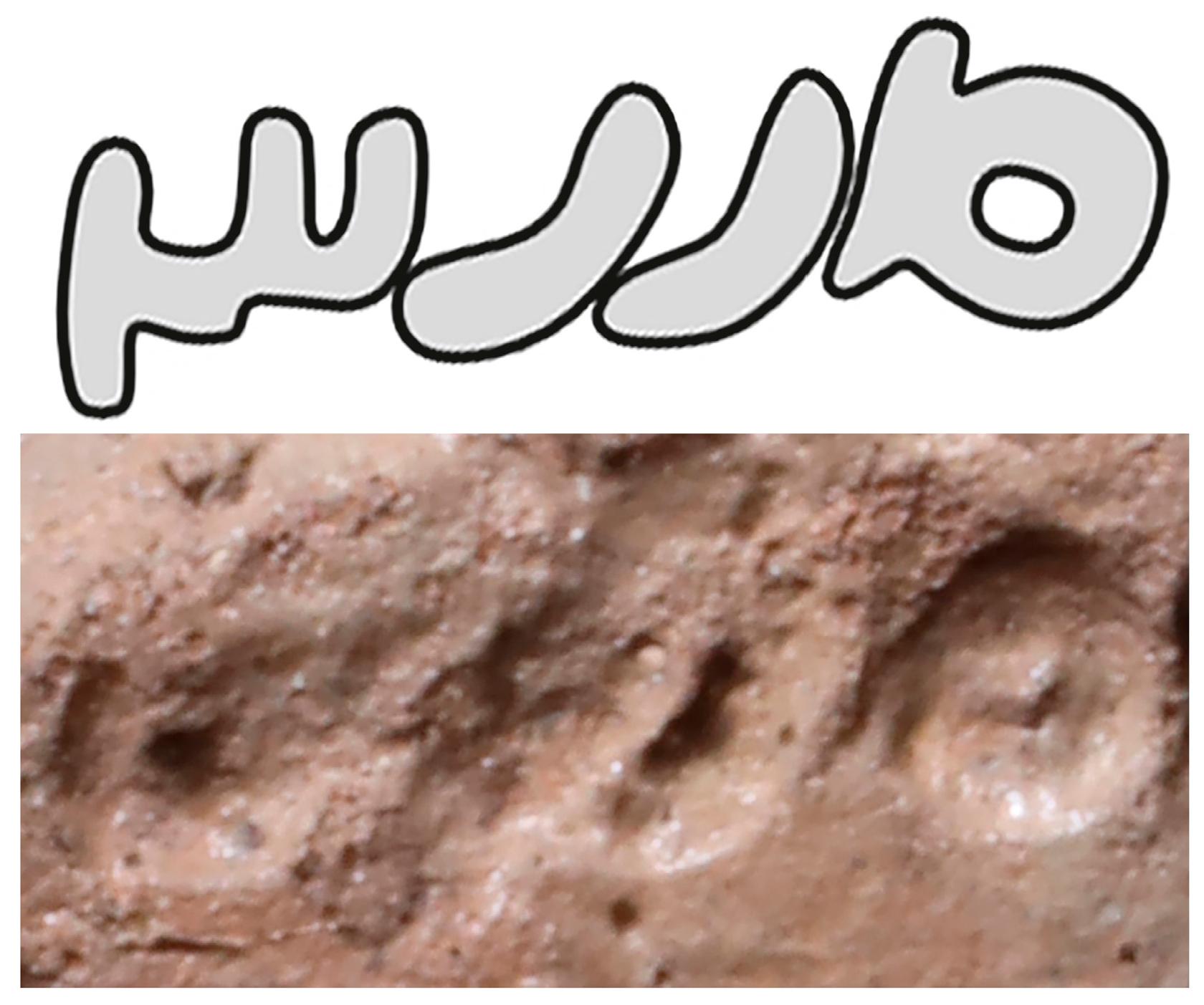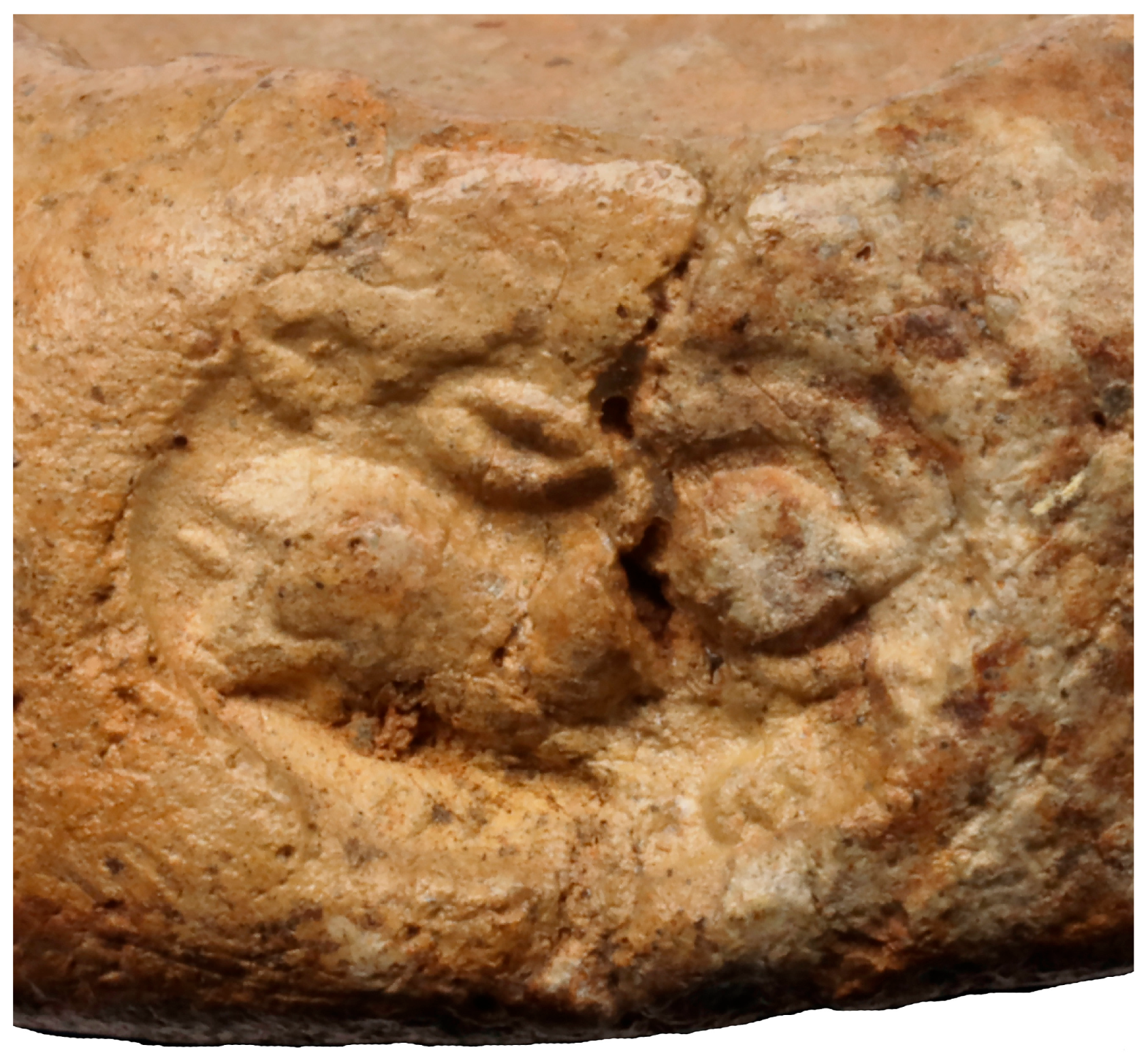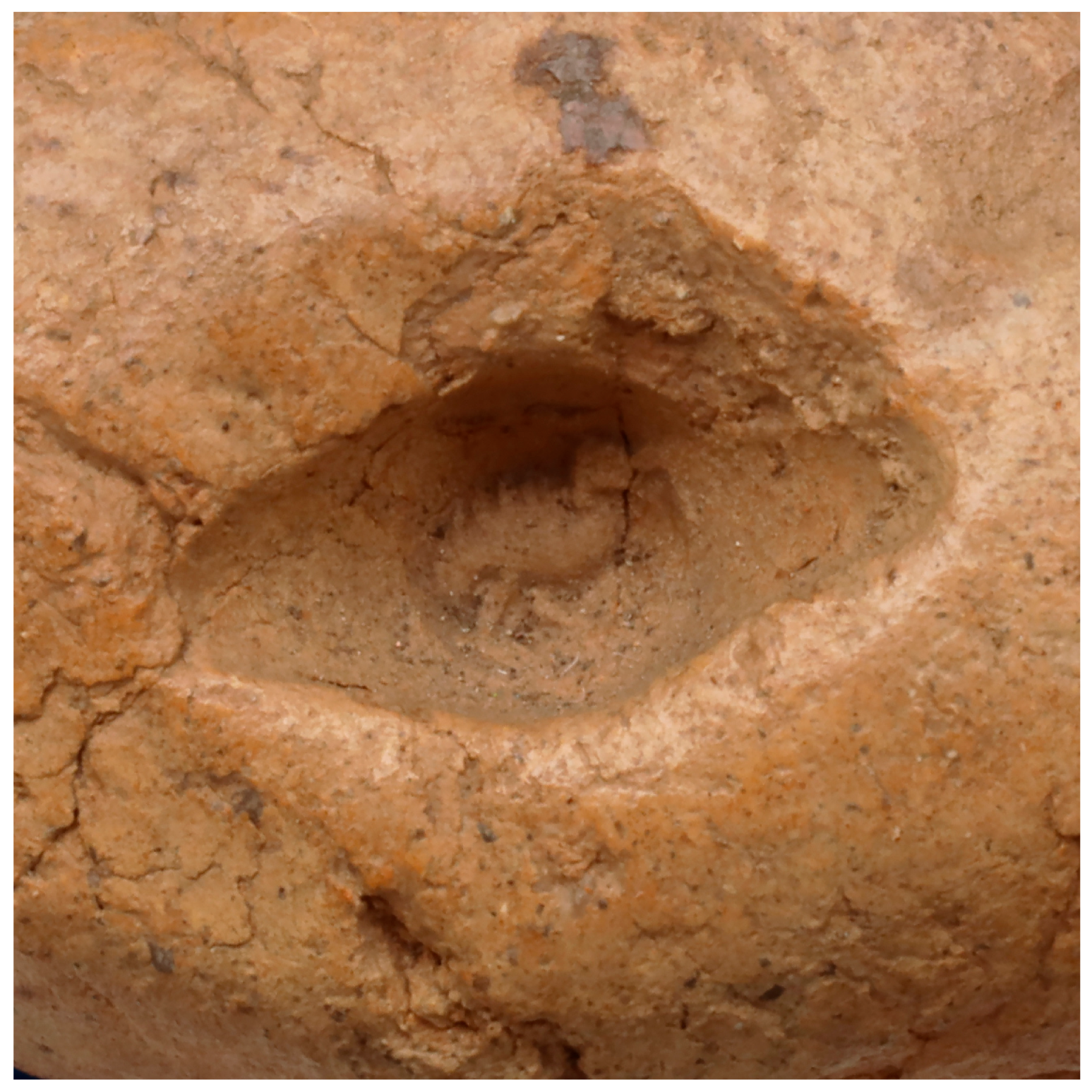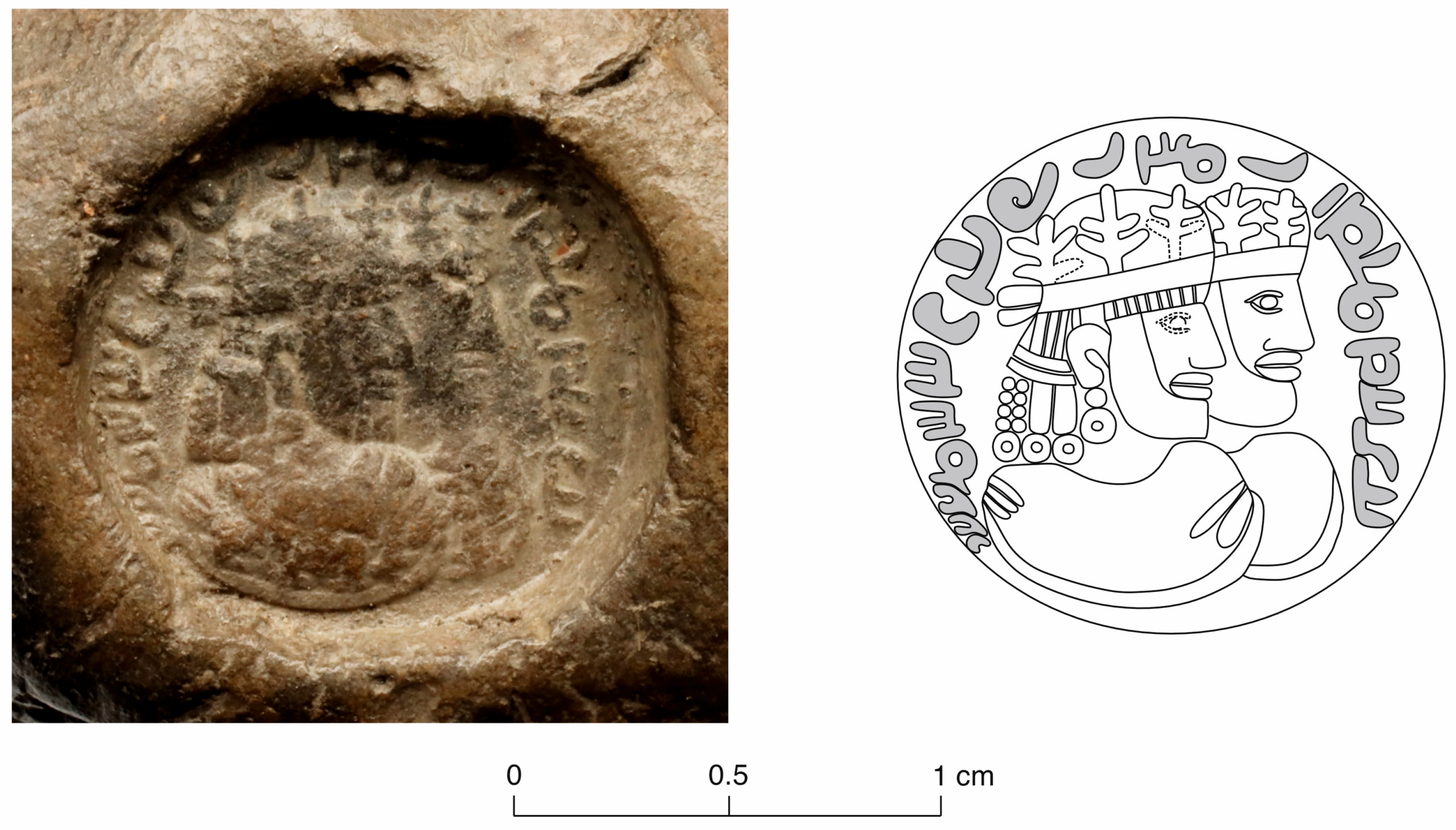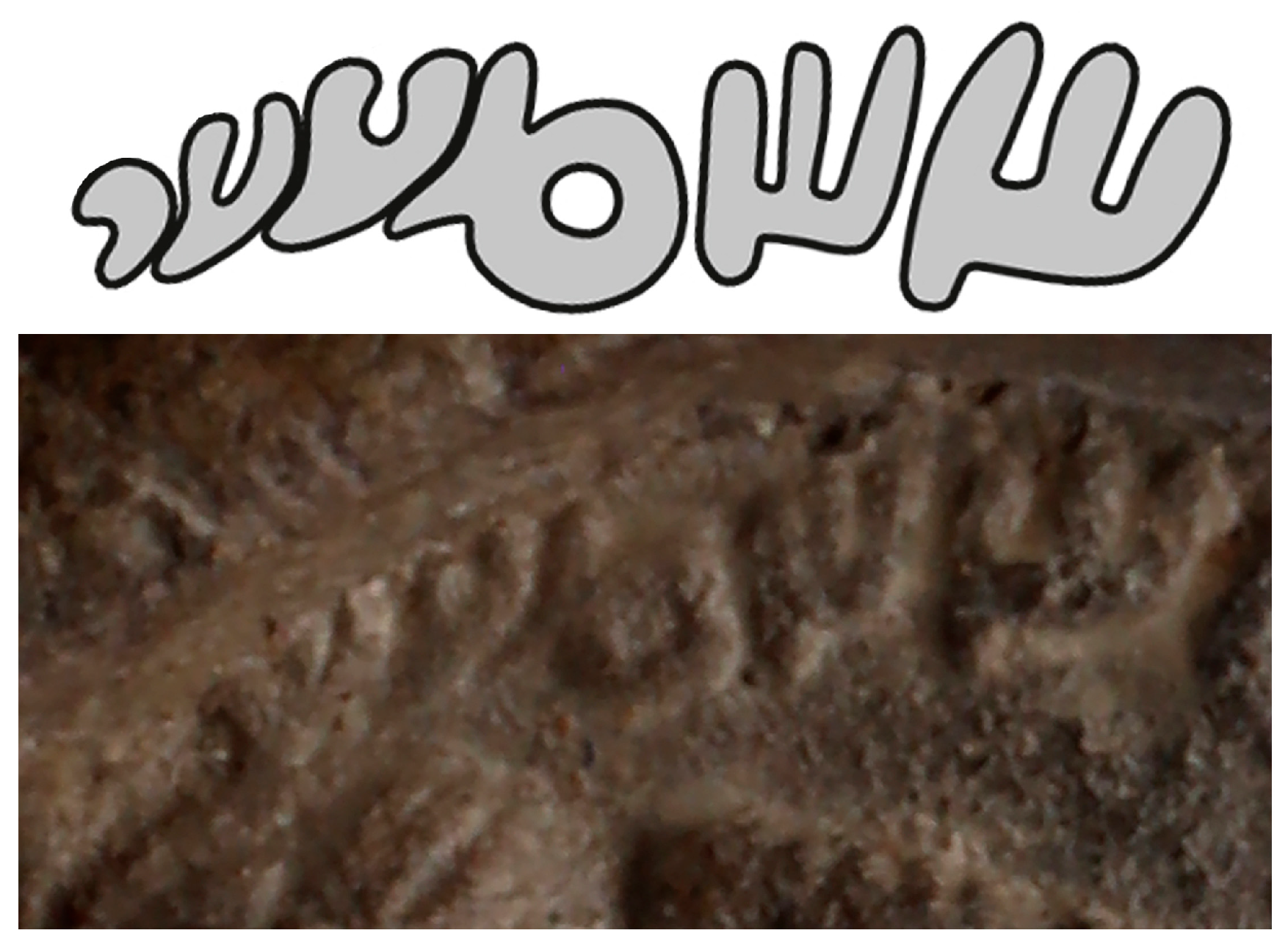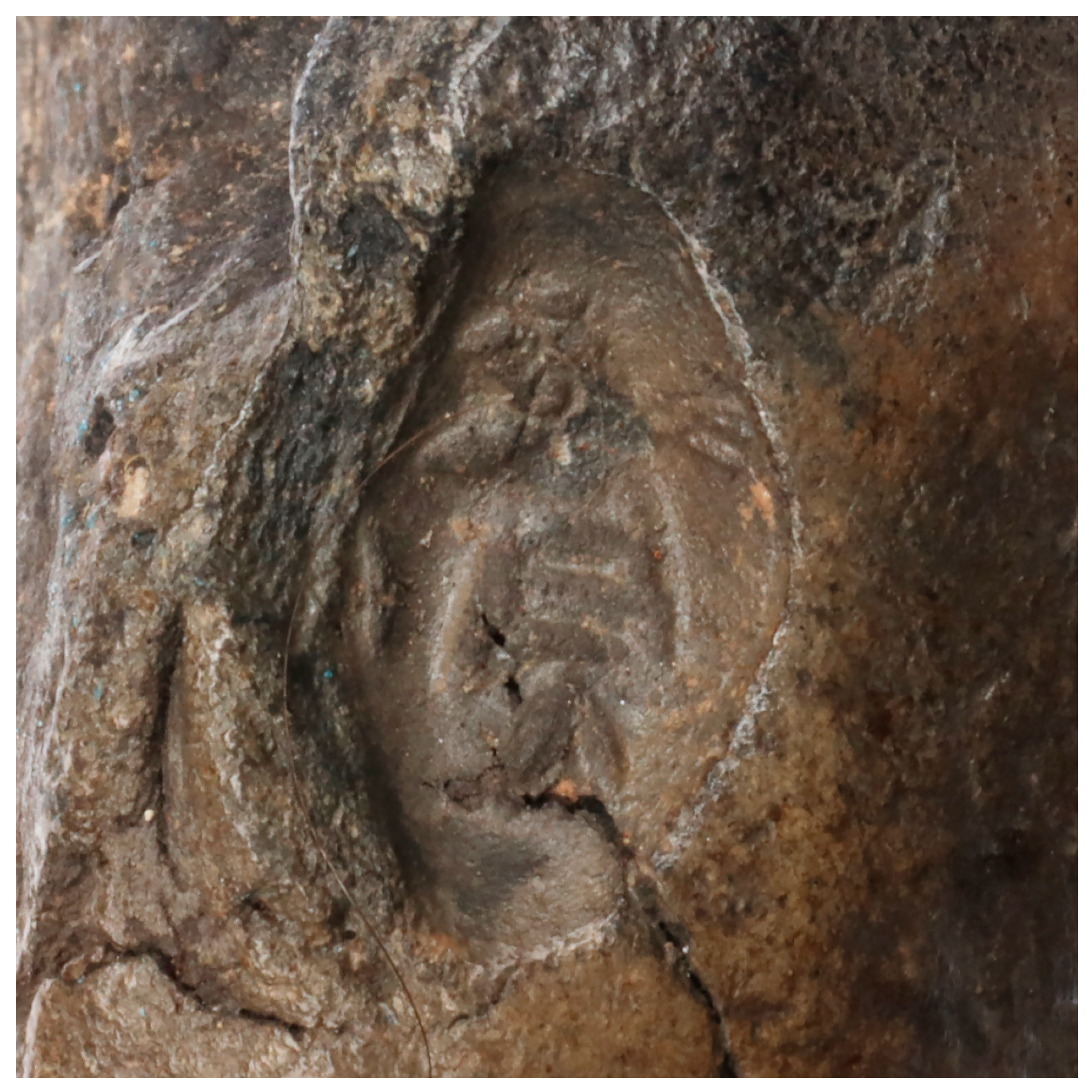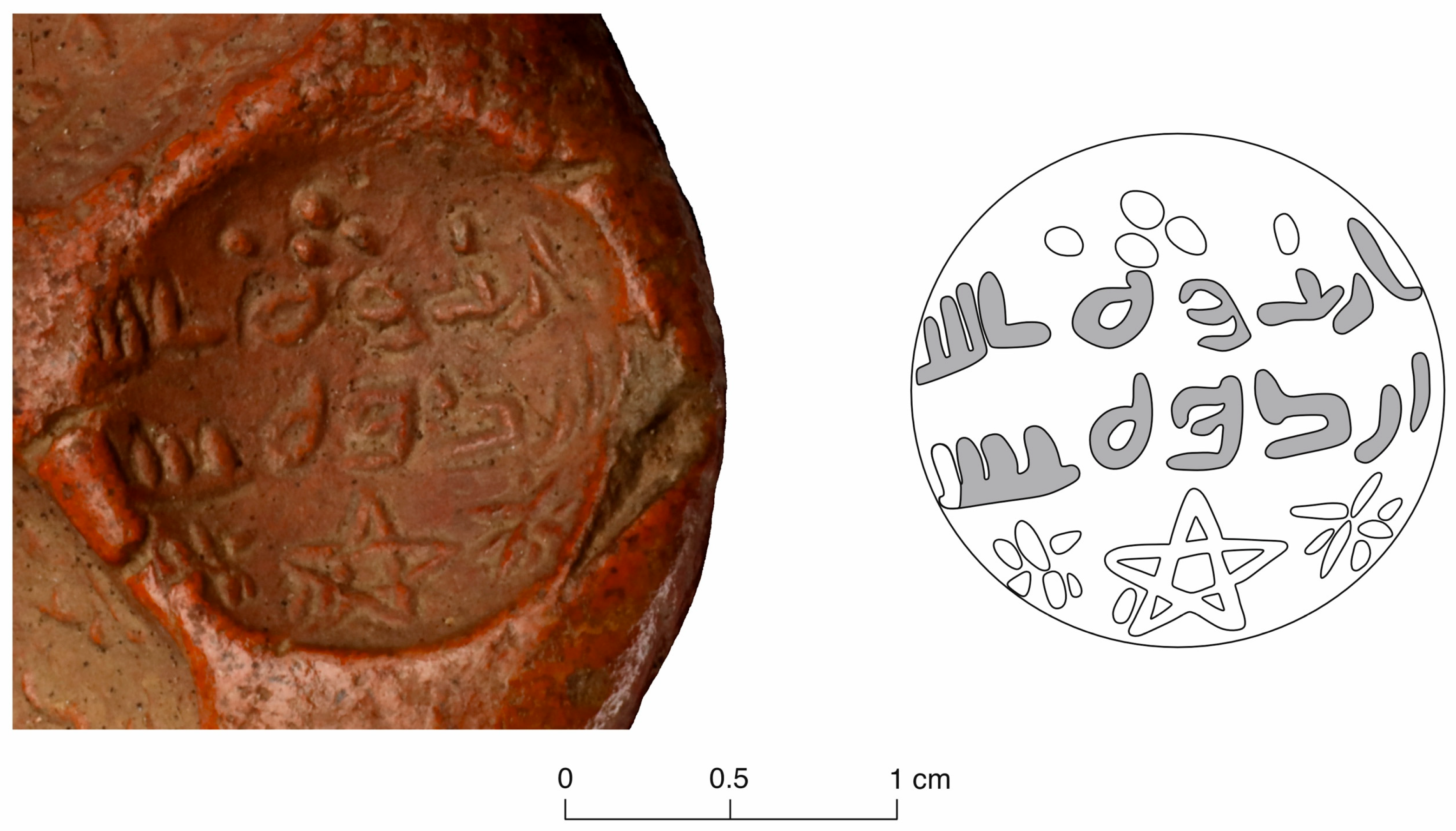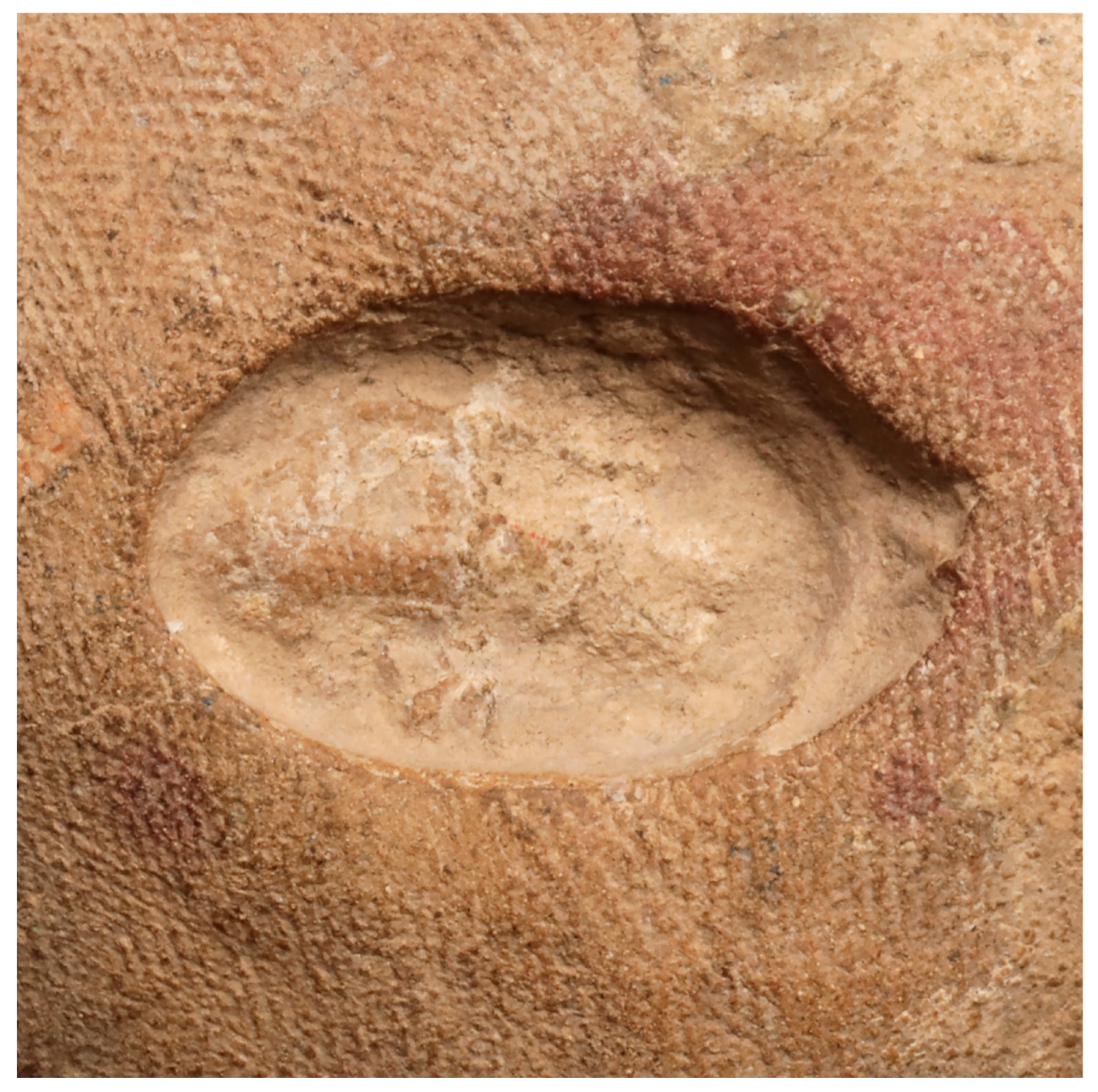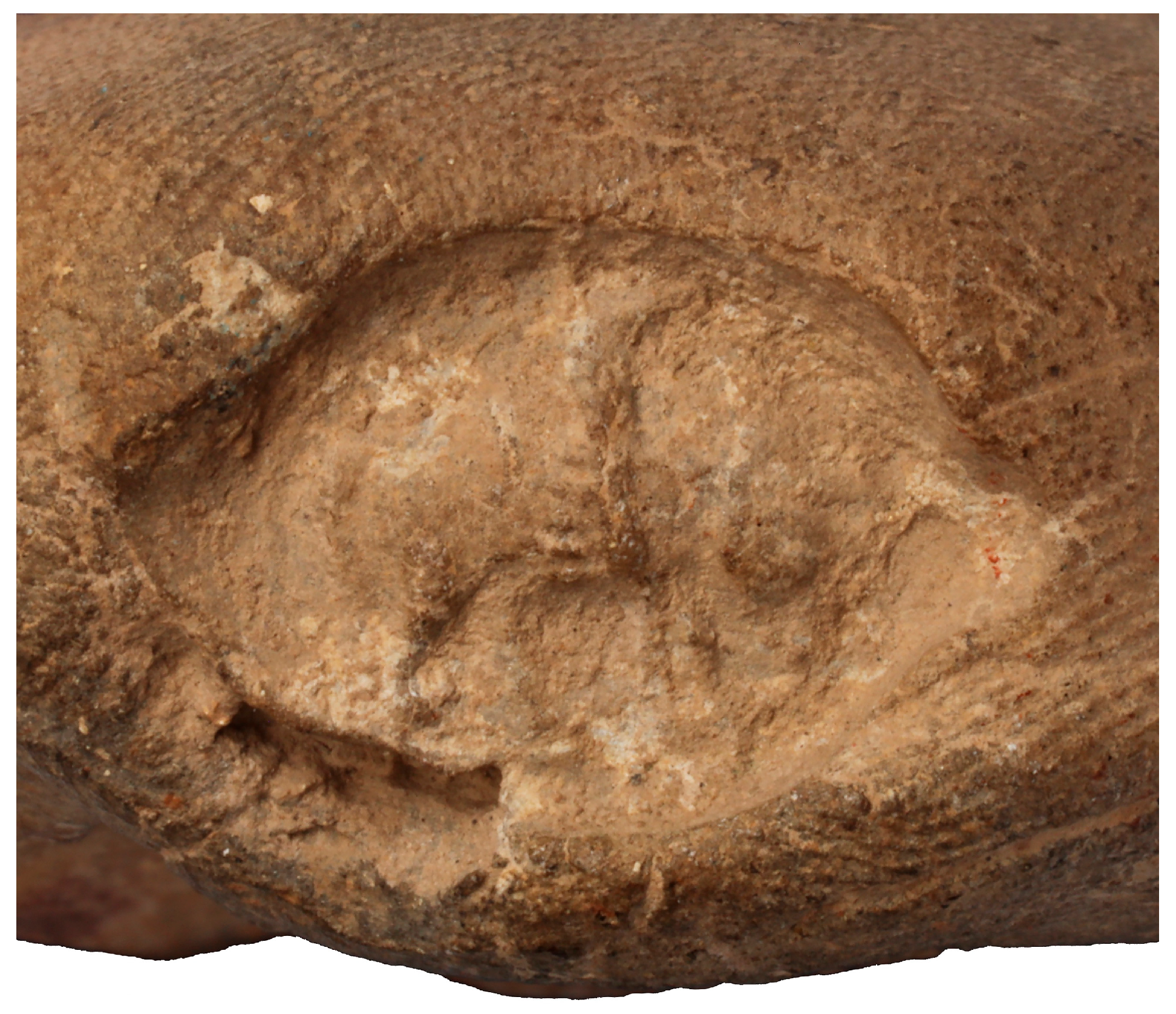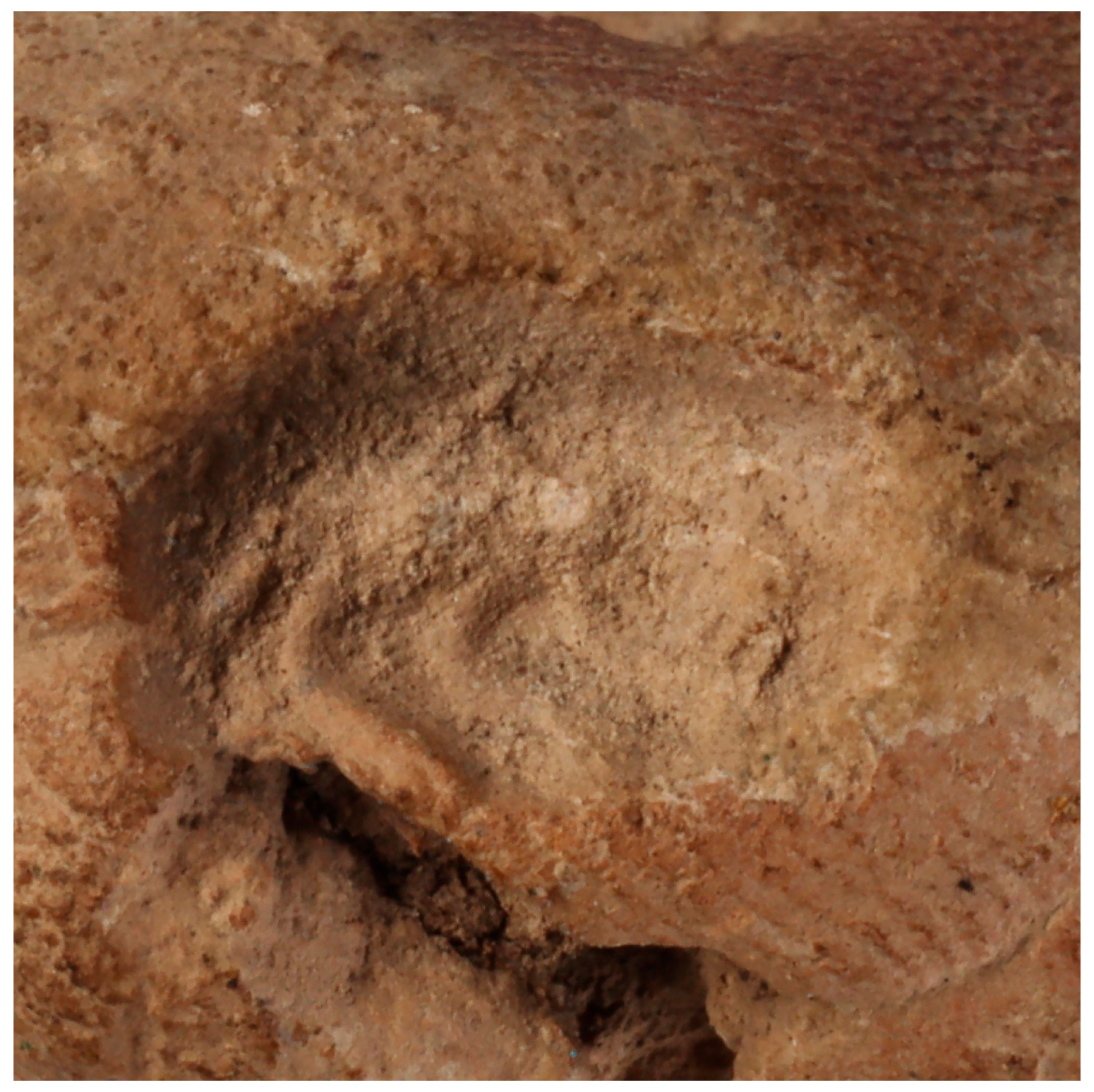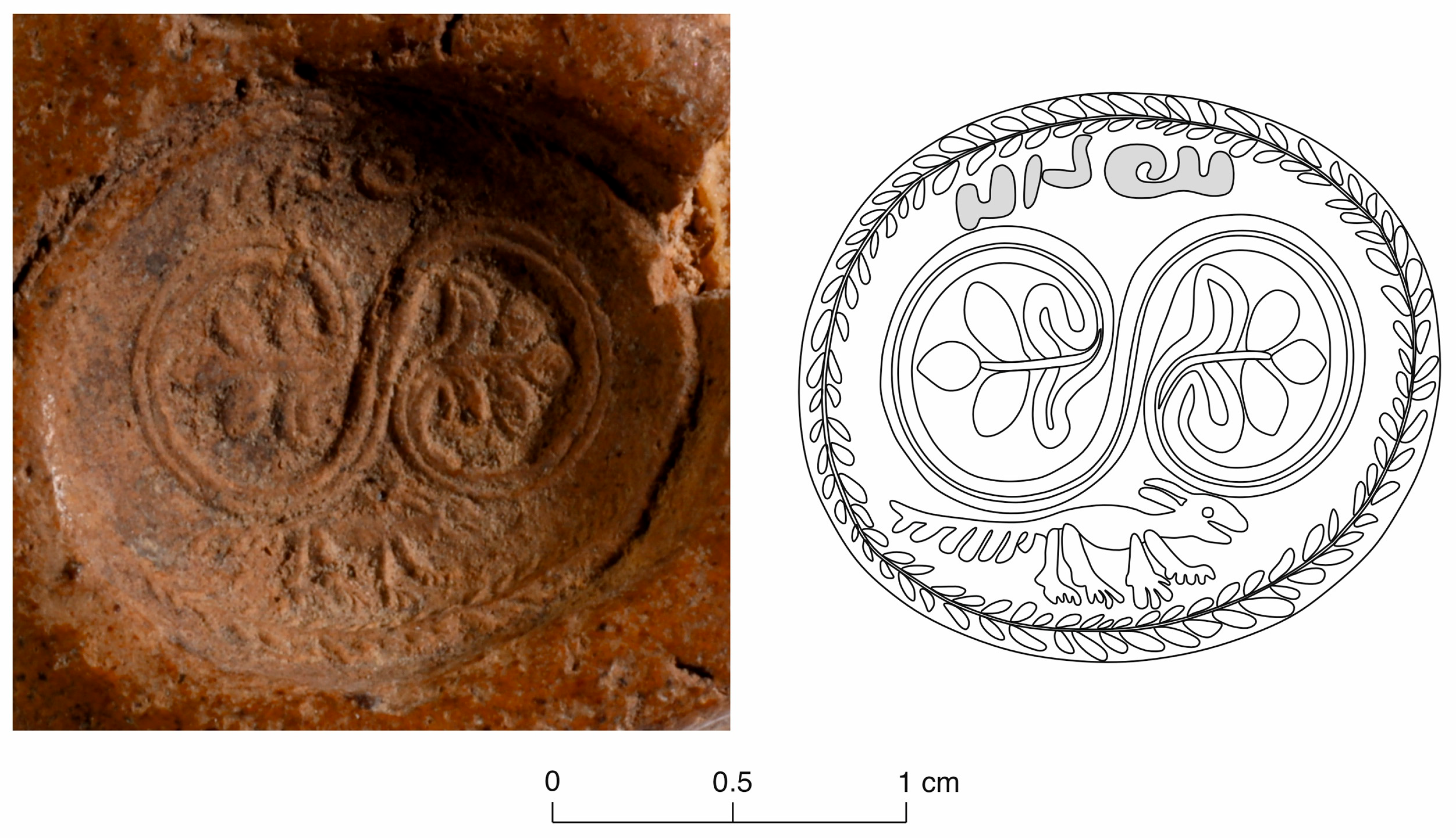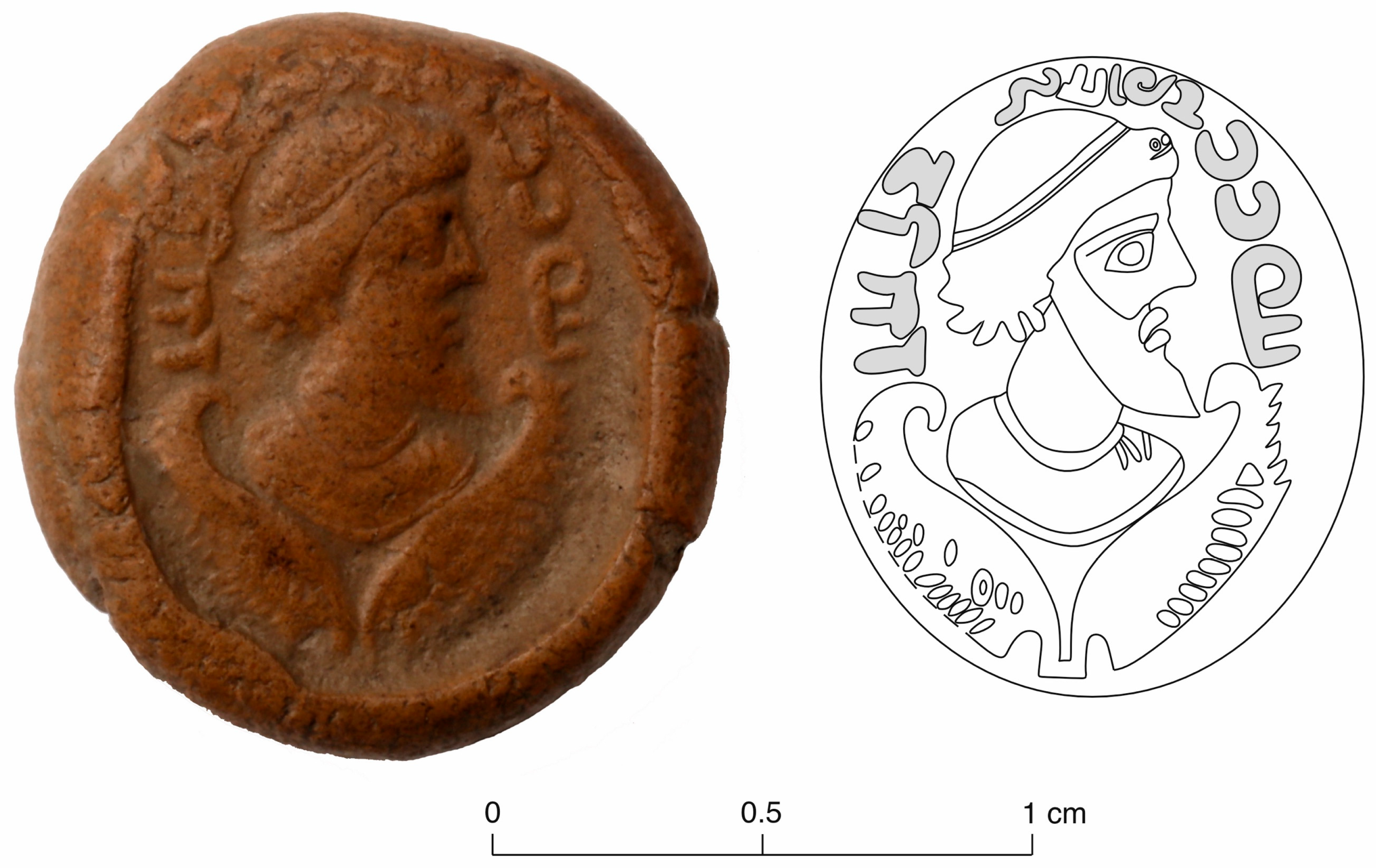2.1. Bulla 214, Seal Impression 1
At 9 o’clock, an impression, 18 × 18 mm, of a circular seal with a flat engraved face appears. The seal impression displays no image and only text. The text consists of three lines at the centre and one line in the margin, all in Middle Persian lapidary script (
Figure 2).
Frye (
1970, p. 83) reads the inscription as follows:
| At the centre: | |
| Line 1 ⟨n]ywš[x]⟩ | Nisha- |
| Line 2 ⟨p[w]xl⟩ | pur |
| Line 3 ⟨mgwx⟩ | magūkh(udā) |
| In the margin: | |
| ⟨ʾplštl⟩ | Abaršahr |
Later,
Gyselen (
2019a, pp. 23–26, 431, ATb256a) published a drawing of this seal impression and revised Frye’s transliteration, transcription, and translation as follows:
| Centre: | |
| Line 1 (starting at ca. 2 o’clock) | ⟨[n]ywš[h]p⟩ |
| Line 2 (starting at ca. 3 o’clock) | ⟨[w]hl⟩ |
| Line 3 (starting at ca. 4 o’clock) | ⟨mgwh⟩ |
| | |
| Margin (From ca. 6 o’clock to ca. 1 o’clock) ⟨ʾplštl⟩ |
| Lines 1–3 | /nēw-šābuhr mowūh/ |
| Margin | /abaršahr/ |
| | |
| ‘Mowūh de Nēw-Šābuhr, (province de) Abaršahr’ |
Gyselen (
2019a, pp. 23, 431) shows two annulets preceding and following the inscription in the margin through drawing (
Figure 3). However, a close examination of the seal impression on the bulla itself suggests that the second circle in the drawing could represent the letter
mēm ⟨m⟩, although its placement does not align with the expected content of the inscription. However, some other Sasanian seals and seal impressions do bear single letters as abbreviations for toponyms, some of which remain to date unidentified. The possibility cannot be excluded that the
mēm ⟨m⟩ on this seal impression serves a similar function. Regarding the third circle at 9 o’clock in
Figure 2 above (not represented in Gyselen’s drawing reproduced in
Figure 3 below), it is tempting to interpret it as final ⟨y⟩ for the word ⟨nywšhphl⟩ and read it as ⟨nywšhphly⟩, a form attested on other seals (
Gyselen 2019a, p. 423, ATb42a). However, the distance between ⟨l⟩ and the supposed ⟨y⟩ is too great to support this interpretation. The circle which in Gyselen’s drawing precedes the first letter (
aleph) of the name ⟨ʾplštl⟩ written in the margin, should instead be represented as a rectangle, as this is the form it has on the seal impression (
Figure 2).
Apart from the interpretation of the circles in the margin, there is no ambiguity concerning the reading of the inscription in the margin. Some uncertainty, however, surrounds the reading of the characters at the centre because some letters in line 1 are damaged. This makes it difficult to read them with confidence. Gyselen’s drawing (above,
Figure 3) shows all characters preceding ⟨š⟩ as being lost, although she transliterates the first line at the centre as ⟨[n]ywš[h]p⟩ (
Gyselen 2019a, p. 431, ATb256a). Her restoration implies that the engraver has omitted the character ⟨h⟩ before ⟨p⟩.
The new images we have been able to take of the seal impression confirm Frye’s and Gyselen’s restoration of the first letter in line 1 in the centre as
nūn. The following sign can be recognised as
yōd. The third letter appears to be a
wāw which is placed above the lower horizontal line of the character
yōd. While the last letter of line 1 is a clear ⟨p⟩, the preceding characters are not entirely clear due to damage to the clay after the characters ⟨nyw⟩ (
Figure 4).
Although there is no question that lines 1–2 at the centre attest the place name
Nēw-šābuhr, it is unclear whether three or four vertical lines precede the ⟨p⟩ at the end of line 1. In the former case, the first two vertical lines would belong to the character ⟨š⟩ and the third one would be the tail of a ⟨p⟩. Accordingly, the
wāw would be followed by a gap before the
šīn, similar to another seal bearing the name Nēw-Šābuhr (
Gyselen 2019a, p. 23, ATb42a). It is not unusual for a compound word to feature a gap between its two components. However, the spelling of the name Šābuhr with ⟨šp-⟩ rather than ⟨šʾp-⟩ or ⟨šhp-⟩ is extremely rare, if attested at all.
Gignoux (
1986, p. 161, no. 858) lists a single and uncertain instance in the form ⟨š]pyhry⟩ in TS18 (
Göbl 1976, p. 44, Tafel 63/85). Apart from the first character being restored, the spelling of the name with
yōd rather than
wāw also renders Gignoux’s identification of that name in TS18 as doubtful. In the absence of any clear evidence for the spelling of the name Šābuhr with neither
hē nor
aleph in the first syllable, one would have to assume that the seal cutter accidentally omitted one of these characters.
Gyselen (
2019a, p. 431, ATb256a) accordingly adds a
hē to her transliteration of the name. However, there is little justification for the omission of a character considering the word space after ⟨nyw⟩. It therefore seems worthwhile to consider the option of seeing four vertical lines preceding the ⟨p⟩ at the end of line 1. The first vertical line is partly damaged, but the character ⟨š⟩ can be recognised, followed by ⟨ʾ⟩ and ⟨p⟩, which would have no tail. There is no uncertainty about the reading of lines 2 and 3. We therefore transliterate the inscription in the field as follows:
| Centre: | |
| Line 1 (starting at ca. 2 o’clock) | ⟨nyw šʾp⟩ |
| Line 2 (starting at ca. 3 o’clock) | ⟨whly⟩ |
| Line 3 (starting at ca. 4 o’clock) | ⟨mgwh⟩ |
| | |
| Margin (from ca. 6 o’clock to ca. 1 o’clock) | ⟨ʾplštly⟩ |
| | |
| Lines 1–3 | /nēw-šābuhr mowūh/ |
| Margin | /abaršahr/ |
| | |
| ‘Mowūh of Nēw-Šābuhr, (in the province of) Abaršahr’ |
Although the standard spelling of the name Šābuhr is with
hē in the first syllable, spellings with
aleph are also found (
Gignoux 2003, p. 61, nos. 313 and 314). There is no need to assume that the engraver omitted ⟨h⟩ after the
aleph in the first syllable of the name, as spellings with both
aleph and
hē are only rarely attested as, for example, in
Burzād-Šābuhr ⟨bwlcʾt šʾhpwhly⟩ (
Gignoux 1986, p. 61). Similarly in New Persian, the name appears both with and without ⟨h⟩: Šāhpur (
شاهپور) and Šāpur (
شاپور). The city of Nēw Šābuhr is mentioned in the Pahlavi text
Šahrestānīhā-ī Ērānšahr §15 (
Daryaee 2002, pp. 18, 39).
Gyselen (
2019a, p. 134) describes it as the capital of the province of Abaršahr.
Frye (
1968, pp. 120–28;
1970, p. 83) transliterates the word in line 3 as
mgwx and transcribes and reconstructs it as
magūkh[udā]. Later he transliterates and interprets it as
mgw-x(wtʾy) ‘chief priest’ (in a town or district), whom he considers to have been in charge of the town archives (
Frye 1973, p. 50). He refers to the title ⟨ʾtwry ZY mgwxwdʾ⟩ ‘fire of the Magi-chief’, which
Horn (
1890, p. 673, no. 125, pl. IIb) had read on a 5th-century chalcedony seal held in the British Museum.
Bivar (
1969, p. 51, no. 119718, pl. 3, AE4), however, reads it as ⟨ʾtwlyxwdʾt ZY mgwxwdʾt⟩, while
Gignoux (
1987, p. 21) argues that this reading is misleading and rejects the existence of the word ⟨
mgwxwdʾ⟩ on that seal.
The word ⟨mgwh⟩ has been widely discussed by scholars and continues to be subject to debate (
Dang 2022, pp. 84–89).
Maricq (
1959, pp. 267–68) interprets the final ⟨h⟩ of the word ⟨mgwh⟩ as the initial character of the word
ḥʾ
nk, the Persian word
khāna, meaning ‘house’. He reconstructs the term as
mgw-ḥ(ʾ
nk) (lit. ‘
mgwh-house’) and translates it as the ‘bureau des mages’ or ‘office of the magi’.
2 However, abbreviations of this type are unknown in Middle Persian texts.
Frye (
1960, p. 33) reports that Mordtmann and Horn read the term as
magū ZY but that Herzfeld would have pointed out that the last letter of ⟨mgwh⟩ never take the usual form of
ZY but almost always appear as ⟨h⟩. Frye refers the reader to Herzfeld
apud Wilkinson (
1936, p. 180), but in that article Herzfeld puts forward no such argument. Herzfeld assisted Wilkinson in reading the inscriptions, as
Wilkinson (
1936, p. 180, fn. 4) acknowledges, and transcribes the word as
maguh. Without making any attempt to transliterate or transcribe the word and comment on its formation,
Herzfeld (
1938, p. 417) suggests that this term denotes ‘the office of the
mōbed, the
qāḍi’ (judge).
Gropp (
1974, pp. 137–39) argues that
mgwh refers to an institution and traces the word back to Old Iranian
*magupaiθya, through intermediate stages such as
*magūϑya >
magūh (
mgwh). He suggests that the
mgwh institution was similar to the Parsee
punchayet in Bombay. However, this idea is rather anachronistic as the latter is commonly thought to have started only in the 17th century and in the specific context of the Parsi community of India (
Hinnells 1989). According to Gropp,
mgwh designated a ‘Magi administration’ that evolved during the second half of the Sasanian dynasty, when a hierarchical territorial-administrative structure—village, district, province—was firmly established.
Gignoux (
1974, pp. 171, 179, 180, 186;
1978, pp. 6, 16, 17;
1985, pp. 199, 205, 206, 210, 212, 213;
Gignoux and Gyselen 1987) transliterates the term as
mgwḥ and transcribes it as
mogvēh/
mog-vēh, interpreting
mgwḥ as an institution—the ‘
bureau des mages’.
Gignoux (
1984, p. 560, fn. 20;
1987, pp. 22–23) interprets the postulated compound
mog-vēh as meaning ‘mage savant, instruit’, in English ‘learned mage, educated’, on the grounds of the alternative spelling ⟨mgwyd⟩, of which he considers ⟨mgwh⟩ to be a simplified spelling. He connects what he transcribes as
vēh with the old Iranian verb
vid ‘to know’ (
Gignoux 1981, p. 34) and suggests that
mgwḥ referred to an educated priest, probably below the
mowbed but above the simple
mgw, and responsible for the religious administration of a village or a small town, as evidenced by the seal impressions on bullae.
However, as
Khurshudyan (
1987, p. 94) points out, aside from orthographic difficulties, the main problem with Gignoux’s interpretation is that there is not a single seal—whether gem or bulla—where
mgwḥ is accompanied by an anthroponym, while numerous seals bear the word
mgw /mow/ along with a personal name.
Khurshudyan (
1987, pp. 93–94) argues that
mgwḥ is an appellative derived from
mgw, and, because it is represented in different parts of the Sasanian empire—as evidenced by numerous seals bearing this term—it must have referred to an institution that existed throughout the territory of Iran at the provincial, city, and district levels.
Khurshudyan (
1987, p. 95) reports about the view of Livshits, who interprets the spelling ⟨mgwḥ⟩ as
mow(w)ah, meaning ‘abode of the magi’, and derives it from a postulated earlier form
mow(w)ahah, with haplology of
-ah. Khurshudyan reads the word as
mow(w)ih and suggests that it may have referred to a gathering place for magi, similar to the Persian
khānaqāh among Sufis. Since Zoroastrians did not have monastic institutions, he surmises, the term may have come to denote a collective body of local magi, and that this would be the meaning of the word on Sasanian seals.
Sundermann (
1989, p. 362) also rejects Gignoux’s analysis of the word and instead offers the reading
mowī. According to Sundermann, the word might derive from an Old Iranian
*maguθwa- ‘office of the magi’, comparable to the Avestan
aŋhuϑwa- ‘function of
ahu’ and
ratuϑwa- ‘function, office of
ratu’.
Gyselen (
2015) transliterates the term as
mgwh and transcribes it as
mowūh (
Gyselen 2019a, pp. 289–93). While Gyselen provides no philological explanation for this transcription, her transliteration and transcription have gained general acceptance among scholars.
However, a reading
mowīh may be preferable. Since the spelling ⟨mgwh⟩ is based on the historical spelling of the word ⟨mgw⟩, which was pronounced /mow/ at the time this administrative term was probably created, it may be worthwhile considering that the word is formed with the suffix
-īh. It may have been pronounced /mowīh/ ‘office of the mows’. Such an interpretation could be supported by occasional alternative spellings ⟨mgwydy⟩ and ⟨mgwyd⟩ /
mowē/, surveyed by
Gyselen (
2012a, pp. 128–30).
The term ⟨mgwh⟩ appears widely, but only in administrative seals and seal impressions from the late Sasanian and early Islamic periods. A small number of bullae, bearing the term ⟨mgwh⟩, from the Ṭabarestān archive were still attached to mid-eighth-century documents (
Gyselen 2019a, pp. 213–15;
2019b, pp. 151, 154). Within the corpus of the Sasanian administrative seals, the impression of the seal of ⟨mgwh⟩ constitutes the highest number. According to
Dang (
2022, p. 90), this office appears on 21 surviving seals and in 423 seal impressions on extant bullae, suggesting a role tied to local administration at the level of a ‘district’, or ‘canton’ (
tasōg) within a larger province. Recent discoveries of additional bullae have significantly increased these numbers.
The term
mowūh is entirely absent from Zoroastrian literary sources (including the
Sasanian Low Book), rock inscriptions and even Manichaean Middle Persian texts. Therefore, the meaning of this word is established solely from the inscriptions on seal stones and bullae. Despite ongoing ambiguities regarding its accurate transcription, meaning, and administrative role, numerous speculative interpretations have been proposed without much, if any, corroborating evidence. For instance, it has been defined as ‘bureau des mages’ (
Maricq 1959, pp. 267–68;
Gignoux 1987, p. 20), ‘[
mgwḥ] désignant la communauté locale, tout comme dans une paroisse, catholique’ (
Gignoux 1991, p. 67), ‘the magi administration, an institution probably not differing much from the Parsee punchayet in Bombay’ (
Gropp 1974, p. 138), ‘council of the magi’ (
Gubaev et al. 1996, pp. 55–57), ‘the office of the Magi’ (
Wiesehöfer 2001, p. 188), and ‘office of the moγ’ (
Cereti and Bassiri 2016, p. 15).
Gyselen (
2019a, pp. 296–97) believes that the translation ‘bureau of the magi’ proposed by most authors is appropriate for the collective nature of the administration at the district level of the
mowūh. She further hypothesises that the local or regional administration of the
mowūh operated under the authority of a higher official, such as the
mowbed or
drīyōšān jādaggōw ud dādwar, although she acknowledges the lack of direct evidence for such a relationship. Similarly,
Wiesehöfer (
2001, p. 188) argues that the
mowūh, exclusively functioning at the district level, handled the settlement of disputes locally and thus served as a mediating authority for the offices of the
mowbed or
drīyōšān jādaggōw ud dādwar, both of which operated at the provincial level.
Dang (
2022, p. 95) suggests that the
mowūh administration may have functioned independently of the
mowbed at the local district level, with the
mowbed possibly intervening only in specific cases or legal matters.
2.2. Bulla 214, Seal Impression 2
At 3 o’clock, an impression, 18 × 18 mm, of a circular seal with a flat engraved face appears. It features a standing male figure shown in profile, facing to the right (
Figure 5). The head is oval-shaped and proportionate to the body. No clear indication of head covering is discernible due to serious damage. His hair is depicted hanging from the back of the head, although the details are somewhat eroded and unclear. Despite the severe deterioration, the face retains traces of a prominent short nose, a large fully opened eye with prominent eyelid, and full lips. The beard is very faint, giving only a general impression of the length rather than detailed characteristics. The eyebrows and ears are not visible.
The right arm of the figure is bent at the elbow and extended forward, with the thumb and forefinger bent towards one another while the other three fingers point upwards. This auspicious gesture could be interpreted as an expression of greeting, admiration, reverence or invocation. The left arm is slightly bent and horizontally extended forwards, holding a circular string of ten large, round beads, likely to represent pearls. The feet are proportionately small and thin in relation to the body. They are shown in profile and positioned awkwardly in opposite directions. It is uncertain whether the figure wears footwear or is barefooted. Although a vertical line extending downwards from the left heel could indicate some sort of shoe, this feature cannot be taken as conclusive evidence, as it may simply represent an overemphasised rendering of the foot’s heel.
The figure is dressed in a long, belted tunic that extends to the ankles, featuring a smooth and simple texture that conveys a sense of formality. The tunic is form-fitting with sharply defined edges, flaring slightly at the bottom to suggest movement or a stylised design. It has a round collar with a prominent neckline but lacks elaborate detailing. Two long strings, serving as a looped belt, extend from the figure’s waist and hang vertically down the front, ending in tassels shaped like bird heads. To the figure’s left, there are a crescent moon and a six-pointed star, which might indicate celestial or religious significance.
The pose of a standing figure raising their right hand, with the thumb and forefinger bent toward one another, either holding a flower or empty-handed, is a common motif in Sasanian seals and, less frequently, on rock reliefs. For instance, on several seals, the goddess Dēn is depicted extending her right hand in this gesture while holding a flower, likely a lily, which is a specific attribute associated with her (
Gnoli 1993). A similar gesture appears on the rock relief at Barm-i Dilak, located 10 km southeast of Shiraz in Fars province, where the Sasanian king Bahrām II presents a flower to the queen (
Shahbazi 1998;
Overlaet 2010, pp. 339–40). Several seals also portray unidentified standing male and female figures performing this gesture while holding a flower in their hand (
Bivar 1969, pp. 63–64, pl. 7, CC 1–13;
Brunner 1979, p. 40, fig. 8;
Gignoux and Gyselen 1982, p. 36, pl. III, 10.1;
Gyselen 1993, p. 77, pl. I, 10.A.4;
2007, pp. 96–97, 10.2–10.3). By contrast, other seals depict male figures seated on a chair or bench (
Gyselen 1993, pl. III, 10.B.18, 10.B.19) or a female bust shown in right profile (
Gignoux and Gyselen 1989, pl. II, 16), all holding nothing with the thumb and forefinger bent toward each other.
The above examples demonstrate that the gesture of extending the right hand, with the thumb and forefinger bent toward one another, either holding a flower or empty-handed, was performed by a deity, a king, or a person, male or female. Although the exact identity of the figure on the seal impression from the Alpaiwalla Museum is unknown, given the content of the accompanying inscription, it is likely that the figure represents a priest in a ceremonial context. A well-known parallel can be found in the rock reliefs of Kerdīr, the high priest of the early Sasanian period, who is shown raising his hand in a gesture of reverence, though with notable iconographic differences. In the relief at Naqš-e Rajab, Kerdīr’s forefinger is bent and points upward, while at Naqš-e Rustam his thumb is directed upward. By contrast, on the Alpaiwalla bulla the hand is extended forward, with the thumb and forefinger bent toward each other, indicating a distinct variant of the reverential gesture.
This seal impression is of the same size as that of the administrative seal, alongside which it appears on bulla 214. Its size and position on the bulla as well as being both iconic and epigraphic suggest that it is the official seal of the cosignatory, while the three smaller seals impressed on the edge of the bulla are those of the witnesses who were present at the sealing process. In the margin of seal impression 214.2, one line of an inscription in Middle Persian cursive script surrounds the standing figure. The letters are partly worn, but the word ⟨mgw⟩ can be recognised at 5 o’clock on the circumference (
Figure 5). Although part of the third letter has disappeared, one can still discern the traces of a complete
waw, and the gap following the character suggests that the word ends here. A similar shape of the character
wāw is found in the word ⟨mgwpt⟩ (
Figure 6) on a seal impression from Qasr-i Abu Nasr (
Frye 1973, p. 60, sealing D.1, pl. I.1 and drawing). The drawing of that seal impression had previously published by
Wilkinson (
1936, p. 181). The presence of the word ⟨mgw⟩ on seal impression 214.2 further confirms the identification of this seal impression as that of the cosignatory. The impression of the administrative seal next to it on this bulla indicates that the cosignatory belongs to the
mowūh administration of Nēw-Šābuhr of the provincial administration of Abaršahr.
Gyselen (
1995, pp. 124, 143–48), who surveys the inscriptions found on seals and seal impressions of magi, concludes that about 80% of them follow the structure of the personal name, the function (
mow) and the father’s name, while ca. 16% omit the patronymic. A small number of inscriptions provide a personal name, the priestly function
mow, and a pious formula (2%) or a personal name,
mow, patronymic, and a pious formula (2%). Accordingly, one of these four patterns is expected to be present in the inscription found on seal impression 214.2 of the Alpaiwalla Museum. Considering that the characters ⟨mgw⟩ appear at 5 o’clock, the inscription should start at 11 o’clock. The area immediately to the left of the head of the standing figure is damaged and the surface of the seal impression is lost. There seem to be traces of two characters, the first of which could possibly be
aleph,
sāmekh or
šīn and the second perhaps a cursive
ḥēth/hē (
Figure 7), although, due to the damage to the surface, it is not entirely certain that the traces to the left of the head are letters at all. Assuming that they are letters, possible readings could be /sah-/ or /šāh-/.
Gignoux (
1986, p. 156, no. 822) records a personal name
Sahād, whose first syllable he explains as an abbreviated name formed from the present stem
sah- ‘to seem proper’. Alternatively, the first part of the name could be the word
šāh ‘king’. This word is present in the hypochoristic name
Šāhag, which, however, is spelt with
aleph and
hē in the first syllable (
Gignoux 1986, p. 163, no. 866). The following character looks like
pē followed by a cursive
lamed and a
nūn, thus possibly providing the reading ⟨pln⟩ /
farr/, although this also remains uncertain. The next letter looks like another cursive
lāmed. The following character could possibly be read as a
tāw. The traces which follow show two short vertical strokes and a fat horizontal line at the bottom. Possibly the first vertical stroke and the horizontal line represent a
gimel followed by a cursive
wāw or, possibly, a cursive
nūn or
rēš. The next letter has disappeared, but traces are present in the form of a line which is bending to the left at the top and bottom. This is followed by a second curved line of about the same shape. The shape of the two curved lines could point to the characters ⟨s⟩ or cursive ⟨š⟩, although the second curved line could also be interpreted as representing ⟨b⟩. However, that would leave the preceding first curved line unexplained.
Based on these considerations, the resulting reading of the characters to the left of the standing figure is ⟨šhplnltgws⟩. These characters should represent the personal name of the owner of the seal, possibly starting with
šāh ‘king’ followed by
farr- (< Old Persian
farnah-), which also occurs, for example, in
farrbay, a compound of
farnah- ‘glory, light’ and
baga- ‘god’. The next part of the name could be /rad/ (Avestan
ratu- ‘master, judge’), which also appears, for example, in
Mānrad (
Gignoux 1986, p. 116, no. 564) and
Bayānrad (
Gignoux 1986, p. 56, no. 196). The final element ⟨gws⟩ or, perhaps more likely, ⟨gwš⟩ according to the reading presented here, would turn the name into a four-part name like, for example,
Ādur-Farrbay-Gušnasp (for this and more examples of three-, four- and five-part names, see
Gignoux 1986, p. 35, nos. 55–57, p. 36, no. 67, p. 56, no. 194, p. 81, nos. 344–47, p. 88, no. 384, p. 97, no. 440, p. 108, no. 514, pp. 108–9, nos. 514–16, p. 111, no. 534, p. 183, no. 1007, etc.). While no interpretation for the reading ⟨gws⟩ /
gōh?/ emerges, the reading ⟨gwš⟩ could represent MP
gōš ‘ear’ (OP
gauša-), which
Gignoux (
1986, p. 55, no. 189) considers to be present in the name
Bargōš and for whose first part he considers a Semitic origin. Another word for ‘ear’,
ōš (Av.
uš- ‘ear’) appears in the name
Ōš (
Gignoux 1986, p. 140, nos. 716–19) and in
Māh-ōš, which
Gignoux (
1986, p. 113, no. 544) translates as ‘qui a l’intelligence de Māh’ and in
Warm-ōš (
Gignoux 1986, p. 175, no. 954). Accordingly, the name on the bulla under discussion would read
šāh-farn-rad-gōš ‘who has the glory of a king (and) who has the listening of a judge’.
To the right of the feet of the standing figure the characters following the word ⟨mgw⟩ /
mow/ are expected to represent the name of the father of the
mow (
Figure 8). The first character looks like
bēth. Then follows a character which could be another
bēth written above the horizontal line of the preceding character, or it could be the first part of an
aleph. If
bēth is read, then the short vertical line visible after it could be the first part of an
aleph and the next vertical line would be its second part, with its horizontal line written further down. However, considering that the horizontal line of the second part of an
aleph is expected to be written at the same hight as the first part, it seems preferable to interpret the second character as an
aleph rather than as a
bēth. The lower part of the third character looks like
zayin. However, since the upper part of the character is a straight vertical line rather than a line bending to the right, it is more likely to be a
bēth. This results in the reading ⟨bʾb⟩ /
bāb/, a name also found elsewhere in Sasanian inscriptions (
Gignoux 1986, p. 52, no. 269;
2003, p. 25, no. 52). The next character, letter 4, could be a
gimel, followed by a vertical line, which could possibly belong to a cursive
wāw,
rēš or
nūn. The next letter 5 can be read as a cursive
tāw and this is followed by what at first sight looks like an inverted
dāleth. This, however, is unlikely. The letter seems to have a horizontal line in the middle which joins the curved line coming up from the bottom. This could suggest a cursive
mēm. However, for a cursive
mēm one would expect some traces of a horizontal line joining onto the curved part on the left of the character. It therefore seems more likely that what appears to be a horizontal line at the centre of the character in fact belongs to the upper part of the character. Upon closer inspection of the bulla itself and with the help of multiple photographs taken from different angles and with different lighting, it appears that the line of the character forms a three-quarter circle open at the upper right, where traces of the line going up are still present (
Figure 9). This suggests the character
pē.
The next character, letter 8, has similarity with a cursive
pē, but since it has traces of a tail at the upper left, a
tāw seems more likely, the small tail being what is left of the vertical line to the left of the round body of the
tāw. The last letters of this part of the inscription are damaged. It seems that what is present are the remains of three letters, letters 9–11 (
Figure 10).
The first of them, letter 9, shows a curved line open to the left and a second line to its left of the same shape. Although the character is damaged at its left part, this could represent a
sāmekh ⟨s⟩. What follows seem to be faint traces of an
aleph. Its right part is damaged, but its left part is visible. The horizontal line at the bottom of the
aleph joins up with the last character, a vertical line that probably represents a cursive
nūn. These considerations produce the following reading of the inscription:
| Starting at 11 o’clock ⟨šhplnltgws mgw bʾbgwtptsʾn⟩ |
| /šāhfarn-rad-gōš mow bāb-gōtaftasān/ |
| ‘Šāh-farn-rad-gōš(?), the priest, son of Bāb-Gōtaftas(?)’ |
While ⟨bʾb⟩ /
bāb/ is well attested in Sasanian personal name, the remaining part of the name as read above remains obscure. The element
-gō- could belong with OIr.
*gau̯- ‘cow, bull’. It is attested in the Middle Persian names
Gōbārān (
Gignoux 1986, p. 89, no. 390) and
Gōbed (
Gignoux 2003, p. 38, no. 145). The element -
tafta- could be the verbal adjective of
tap ‘to be, become hot’, but it is hard to make sense of it in combination with
gaw- ‘cow, bull’. The ending
-ān of the final element -
sān or possibly
-hān could be the suffix marking a patronymic, but the analysis and meaning of a name
Gōtaftas or
Gōtaftah remain obscure.
